In the distant year of 1942, in the city of Stalingrad, now known as Volgograd, took place the largest battle in world history — the Battle of Stalingrad.
As a result of the monstrous meat grinder, in which the troops of Nazi Germany and Soviet Russia clashed, there was a crushing defeat of German forces and a turning point on the Eastern front.
Field Marshal Paulus was captured by the Soviet Union. Stalingrad was leveled to the ground by bombing. Three million people died in the battle.
Stalingrad
Originally, the city was named Tsaritsyn. This name comes from the name of the Tsaritsa River, which in turn has Turkic origins: “sary-su” translates as “yellow water”.
Tsaritsyn was renamed to Stalingrad in 1925. The name was formed from the word “Stalin” — a fictional surname of Joseph Dzhugashvili, the General Secretary of the Bolshevik Party.
The name played its role. It’s not that Hitler had a goal of necessarily defeating the USSR specifically in a city named after Joseph Stalin. Of course, the goal was strategic. By capturing Stalingrad, the enemy would have gained access to oil fields in Baku and Grozny and cut off the Soviet Union from half of all supplies through Lend-Lease, which passed through Iran. This would have been a catastrophe.
But there was a second, ideological moment. The Nazis were truly obsessed with symbolism. The flag on Mount Elbrus alone was worth it, as an entire squad of climbers was sent to install it. German newspapers circulated photographs, boosting morale. Propaganda was such an important component of Nazism that even during difficult periods, horoscopes were printed with positive forecasts.
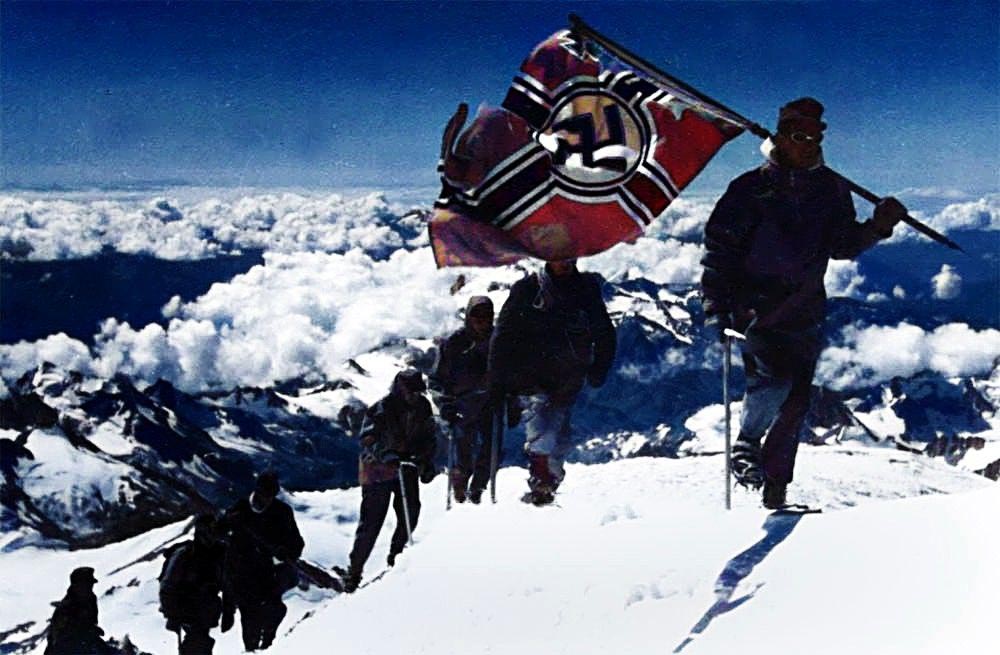
The conclusion drawn from this is that it is not worth naming cities after the surnames of living people — it’s a bad omen. On the other hand, symbolism never works in one direction: Soviet soldiers fought to the death, in part, because they were defending Stalingrad. Prejudices matter a lot. A city named Tsaritsyn might not have held on.
The city was renamed Volgograd in 1961 when they were getting rid of the cult of personality, but the battle remained Stalingrad’s. Since then, no one has attacked the city again.
Butterfly effects
“There’s no ifs in history”, say historians. We won’t use them either, but we will just look at the events that influenced the outcome of the war. We don’t know how history would have developed if these events had not occurred. We want to believe that Hitler would have lost the war one way or another. But how many invisible threads led to what we now call “the turning point”!
War is a chaotic system, a random process over time. It is impossible to analyze the cause-and-effect relationships of such a process, create a war function, and predict what result it will produce if N tanks and M planes are introduced into it. However, already having the result of the war at hand, one can think about what events led to it. Chaotic systems are sensitive to small influences — what mathematicians call the “butterfly effect.”
⁂
In 1940, fascist dictator Francisco Franco refused Hitler’s request to advance troops through Spain to Gibraltar, which ensured Britain’s control over the Strait of Gibraltar — the exit to the Mediterranean Sea. Even before the war began, the British built a military airfield on Gibraltar and turned an old mountain into a network of tunnels and an armed fortress.
Wilhelm Canaris, the head of intelligence for the Third Reich, was sent to negotiate with Franco. He was tasked with convincing Franco at any cost to allow the Wehrmacht to pass through Spain to capture Gibraltar. Canaris went to negotiate with Franco and told him not to even think about getting involved in the war because Hitler had gone mad and was leading Germany to disaster. As it later turned out, Canaris — the chief spy of Nazi Germany — was playing a double game and cooperating with British intelligence.
Göring begged Hitler to take Gibraltar by force. The operation was postponed for a year, but in 1941, there were no longer enough forces for it due to the failure of the offensive against the USSR. At the Nuremberg Trials, Göring called the cancellation of the operation Hitler’s biggest mistake.
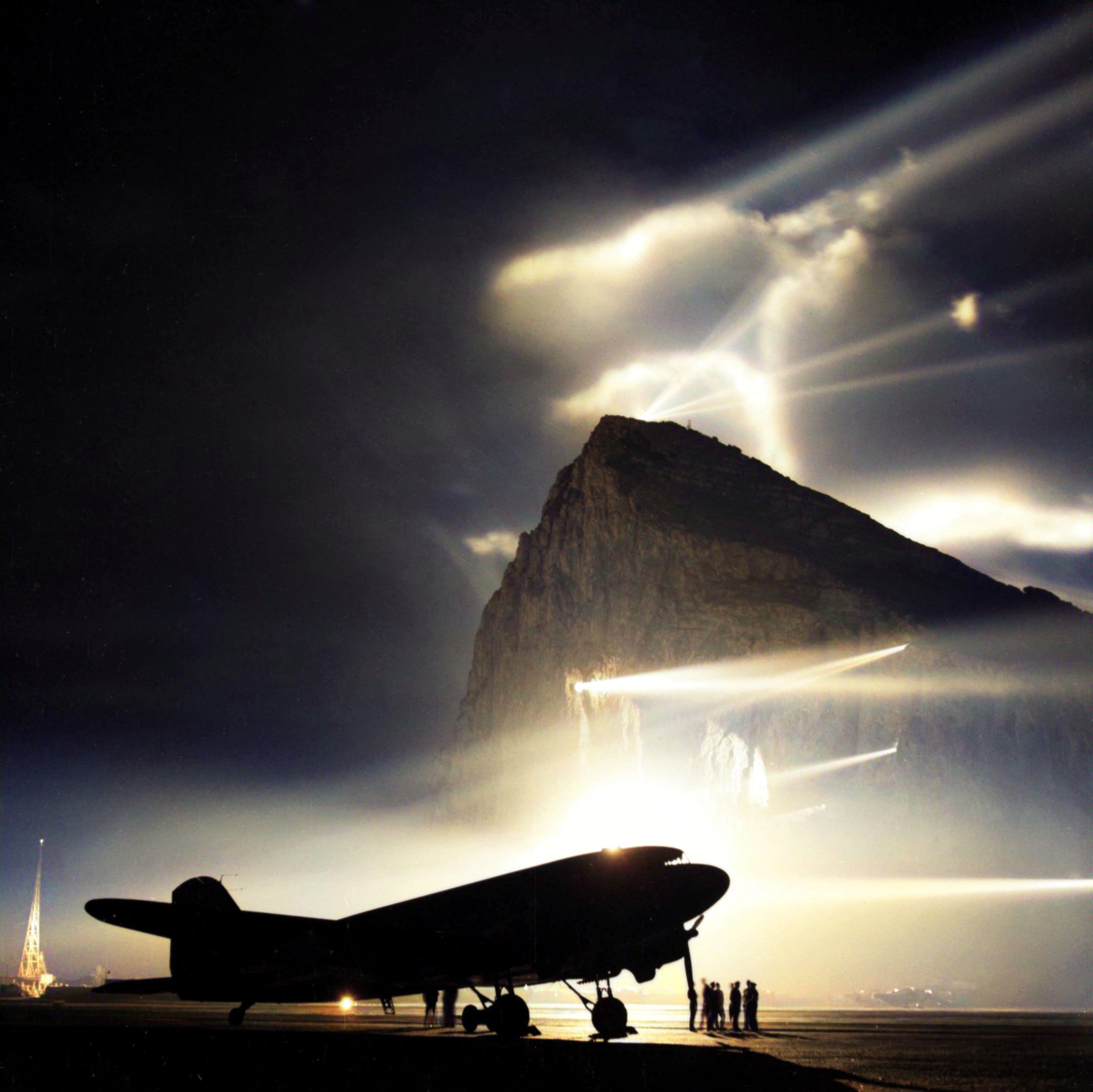
By retaining Gibraltar, the British ensured the supply of Allied troops in Africa. This led to the defeat of General Rommel’s army in Egypt near the city of El Alamein. Hitler’s plans to block the Suez Canal collapsed. Turkey postponed its entry into the war, which thwarted the enemy’s offensive towards the Caucasus from the south and access to Arab oil fields.
In June 1941, Germany attacked the Soviet Union.
In August 1941, when the Wehrmacht was advancing towards Moscow, joint forces of the USSR, Great Britain, and Australia invaded Iran. Although Shah Reza Pahlavi claimed neutrality, he was considered a supporter of Hitler and was overthrown. Allied forces gained control over Iranian oil and established supply lines to the Soviet Union. 45% of lend-lease supplies passed through the so-called Persian Corridor in Iran.
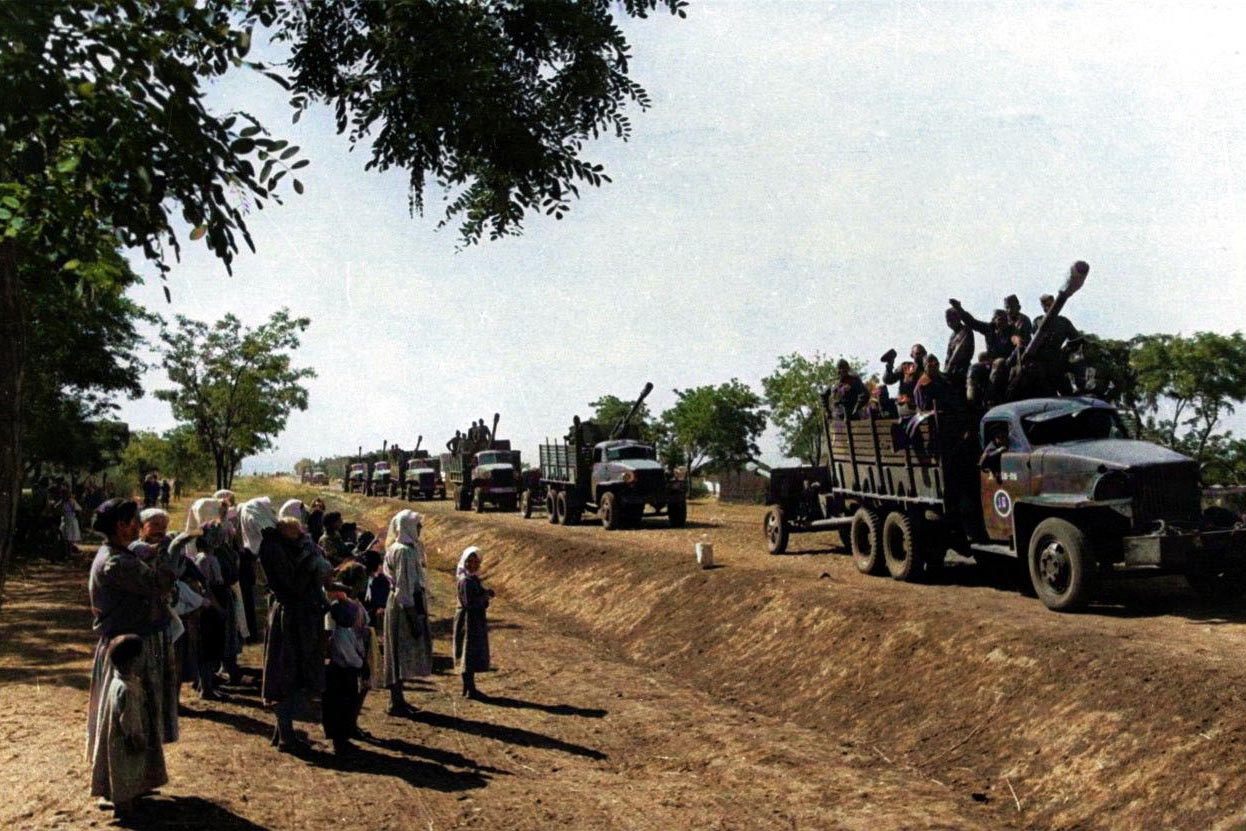
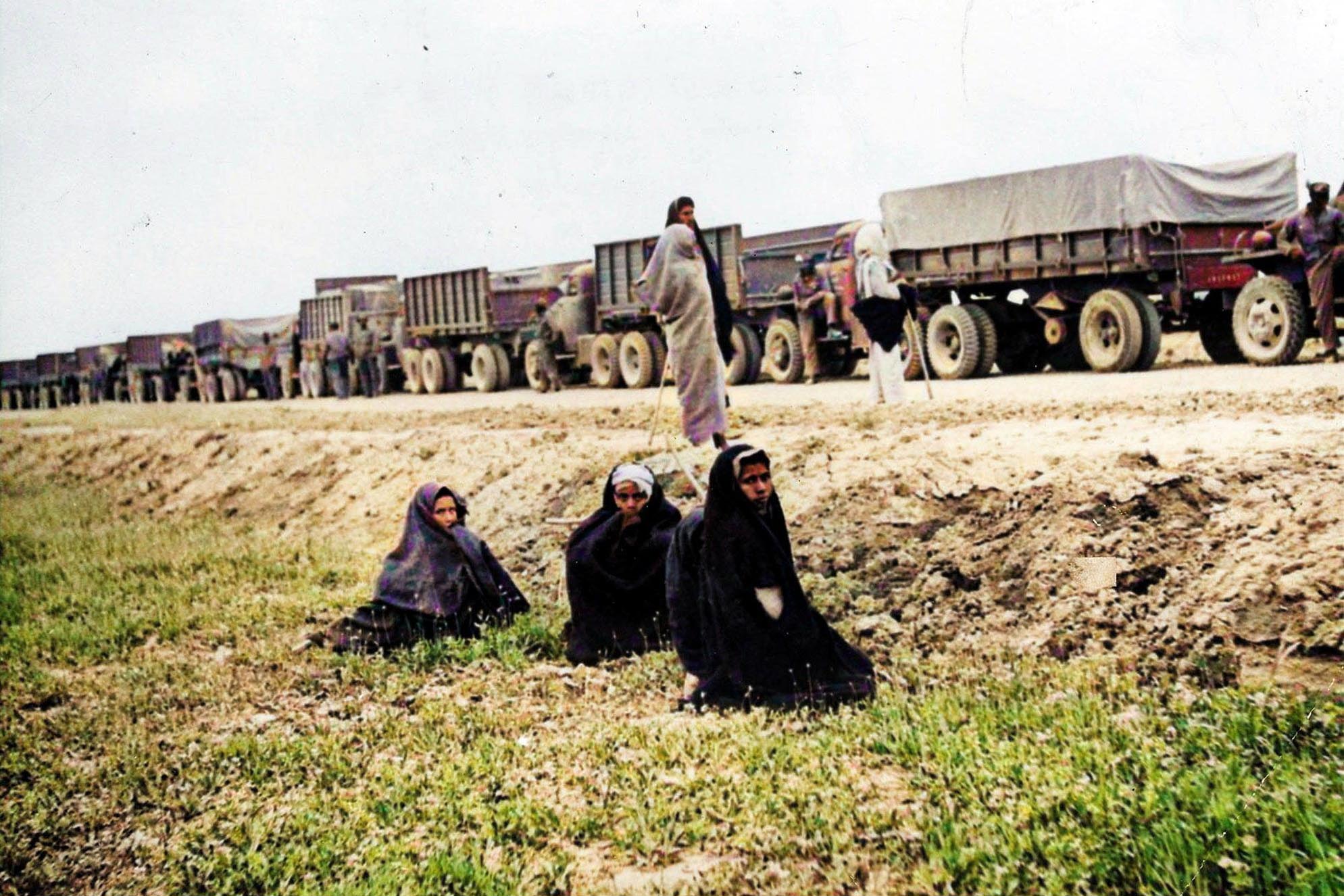
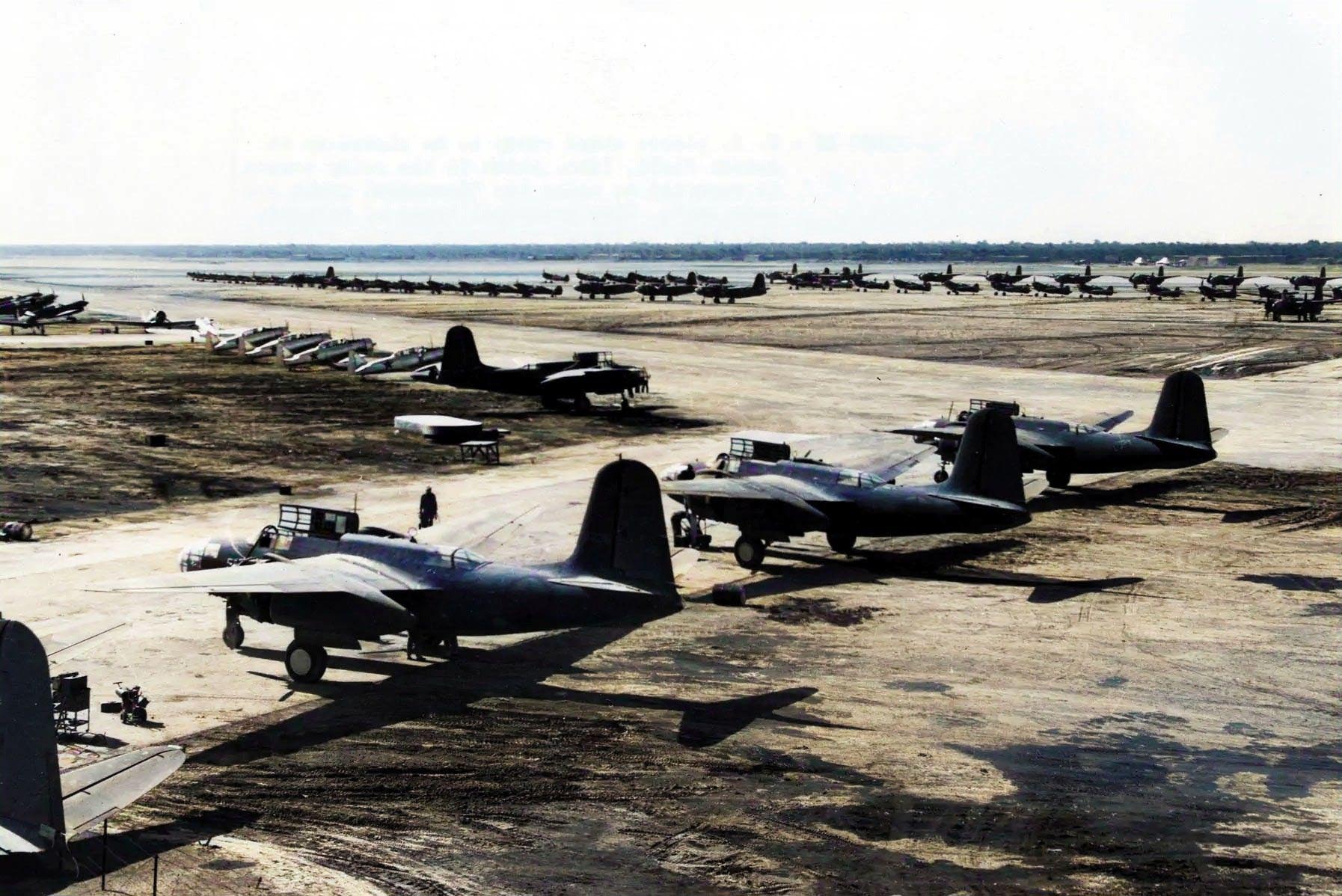
At the same time, a group of British cryptanalysts led by Alan Turing broke the Enigma encryption machine.
Alan Turing
The British cryptographer who broke the German Enigma cipher.
Enigma had been broken before: the Poles did it first long before the war began. But then the Germans increased the number of rotors in the encryption machine, making key search too complex. Alan Turing was the first to apply a cryptanalysis method based on open texts. He noticed that messages almost always contained a stereotypical phrase: for example, the weather forecast began with the same words, and at the end often added “Heil Hitler.” Knowing part of the encrypted text made it possible to quickly and automatically guess the key, which changed every day.
Breaking Enigma allowed intercepting messages of the Third Reich. Although Churchill was not in a hurry to share them with the Soviet Union, Soviet intelligence received all important data. Soviet spies worked in Turing’s team as well as in all significant locations around the world. The most famous of them were the Englishmen John Cairncross and Kim Philby, the Hungarian Sandor Rado, and the German Richard Sorge.
Kim Philby and John Cairncross
The British intelligence officers, members of the “Cambridge Five,” who passed secret data to the USSR.
In November 1941, Wehrmacht troops were stopped 30 kilometers from Moscow. The Blitzkrieg plan failed for the first time, claiming the lives of 7 million Soviet citizens. The Red Army ceased to exist in the form in which it had entered the war.
During the Battle of Moscow, spies Richard Sorge and Kim Philby provided information about Japan’s planned attack on Singapore. This meant that Japan did not plan to attack the USSR. The high command made a fateful decision to transfer reserve units of the Red Army from Siberia and the Far East to the Moscow direction. The final blow pushed the enemy back 200 kilometers by February 1942.
After the failure of the German offensive, there was a dizzying feeling of success in the Kremlin. Stalin, who had already called the war the “Great Patriotic War” in analogy to the war of 1812, drew parallels with the defeat of Napoleon and set the task of defeating Hitler’s troops in 1942. The Red Army began an offensive on all fronts simultaneously.
Such an offensive led to a dispersion of forces. Direct attacks resulted in huge losses. The Red Army was exhausted. By breaking through the front in a narrow area, the army was constantly trapped: the Germans retreated and then cut off the breakthrough from the flanks. This is what happened near Kharkov.
Stalin’s actions led the USSR to the Kharkov Catastrophe, during which the country lost almost 300,000 people while German losses were around 30,000.
Throughout the spring of 1942, intelligence reported that Hitler’s next strike would be in the south to cut off the USSR from oil and food supplies and intercept lend-lease shipments passing through Iran. The Kremlin did not take these reports seriously. Stalin did not trust the intelligence reports and followed the principle: any message must come from three independent sources — only then did he consider it reliable.
The Red Army did not concentrate its troops in the south. Even in the summer of 1942, after the Kharkov Catastrophe, when intelligence reported on the start of the German offensive in the Caucasus, Stalin transferred troops to defend Moscow. Playing on his distrust, Wehrmacht developed a disinformation campaign and mockingly called it “Kremlin.” German intelligence transmitted false reports about an attack on Moscow, and several army headquarters were deliberately moved to areas of the fake offensive.
The plan of the Wehrmacht worked. The forces of the Red Army were distracted from the main attack.
At that time, there was a turning point in the Pacific Ocean. After the attack on Pearl Harbor, the capture of Singapore, and many high-profile victories, Japan planned to attack the next US base. American cryptographers broke the Japanese naval code and learned that the next attack was being prepared for Midway Atoll. At the designated hour, the Americans launched the first strike.
The Battle of Midway became one of the largest naval battles in history and resulted in a serious defeat for Japan. The Imperial fleet was one of the most powerful in the world and surpassed the forces of Germany. In the Battle of Midway, Japan lost four aircraft carriers out of ten, as well as 250 planes. The remaining aircraft carriers were destroyed in subsequent battles. The final showdown was the battle for Guadalcanal Island, in which Japan lost 700 planes. After a series of battles, Japan permanently lost the initiative in the war and shifted to defense.
If this had not happened, Japan could have captured Hawaii, Alaska, Australia, and India, landed on the Arabian Peninsula, and joined forces with Rommel. No one would have stopped Japan from attacking the USSR in the Far East and, together with Hitler, splitting the country into two fronts.
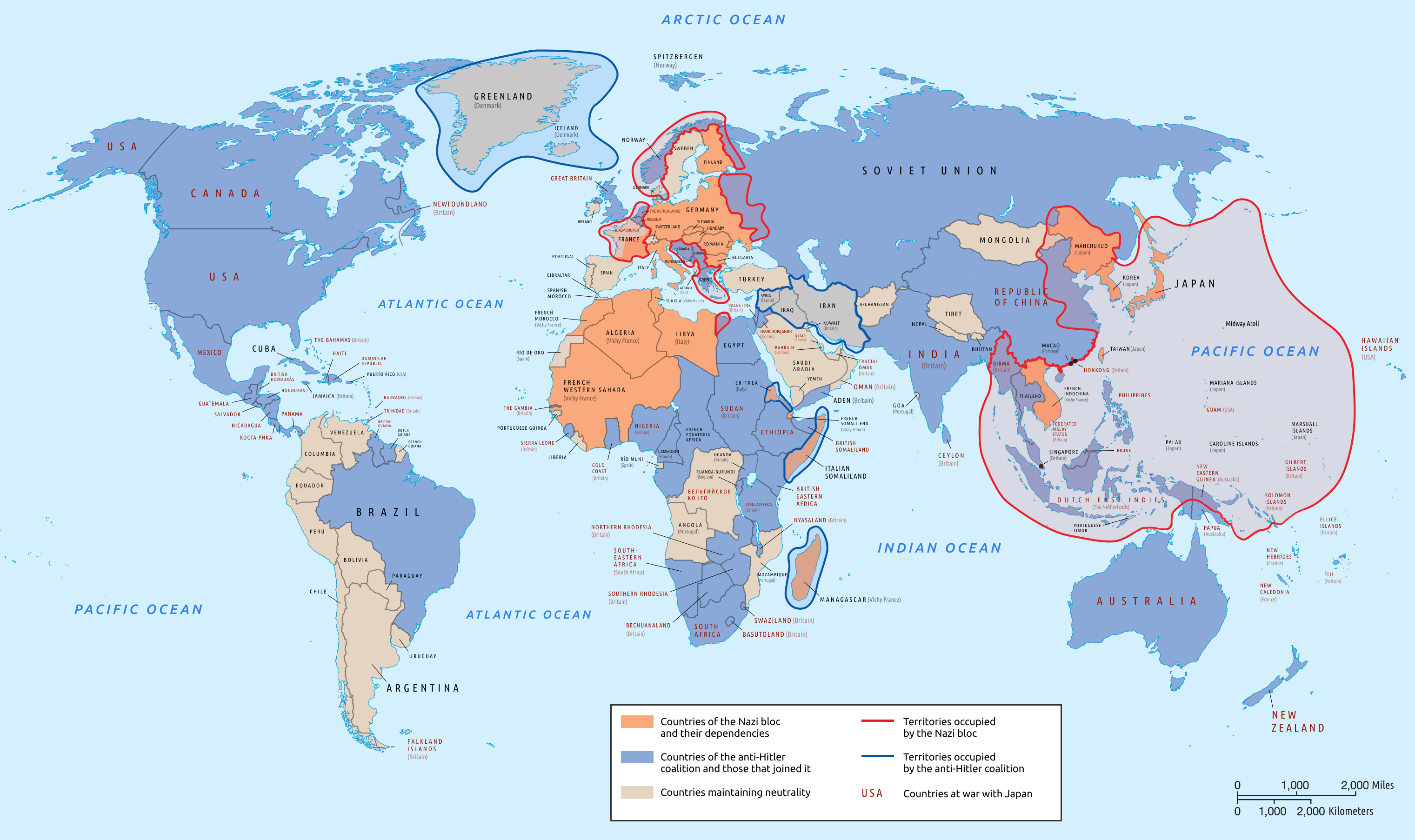
The Japanese imperial troops were no less cruel and inhumane than the Wehrmacht. In the war with China, 20 million people were killed. Japan used chemical and bacteriological weapons, including choking gases that caused skin rashes, sprayed fleas and flies infected with the bacteria of cholera, spread typhus and dysentery, conducted experiments on Siberian plague and vivisection.
Japan’s defeat was greeted with enthusiasm around the world. After the Battle of Midway, the decline of the American market stopped and there was a strong increase in stock prices. Optimism grew even stronger when Hitler began to suffer defeats in Africa.
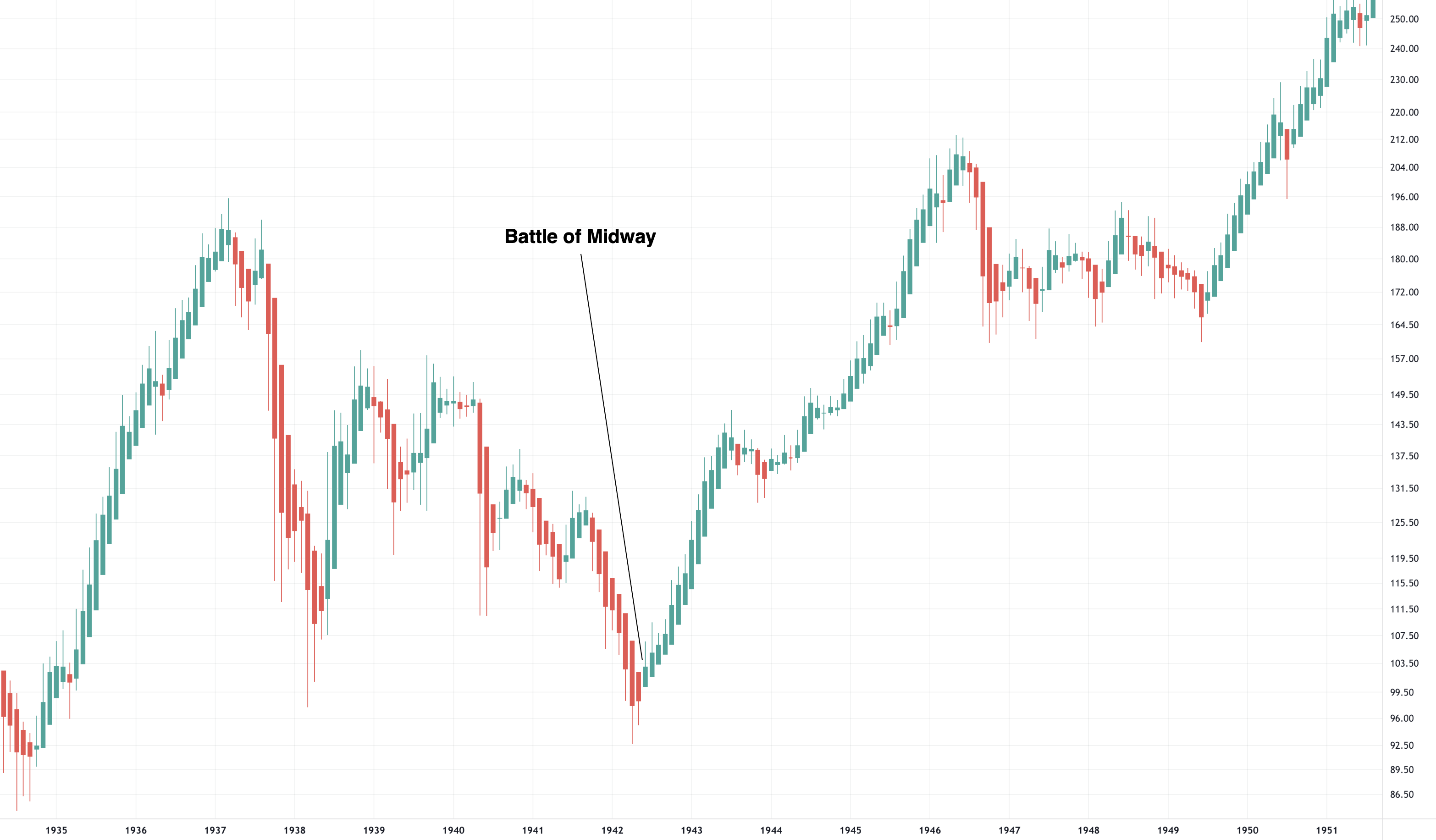
But the main battle of World War II was still ahead. The joint efforts of the allies, a chain of accidental coincidences and outstanding battles, the shadow struggle of intelligence officers and cryptographers — countless butterfly effects converged at one point, opening the way to a decisive victory that had hung by a thread until then.
It was the Soviet Union that had to win this victory.
Attack
The “South” army group was advancing on Stalingrad. Hitler divided it into two parts, one of which went to the Caucasus, and the other to Voronezh and Stalingrad.
The first battle took place on July 17, 1942, near the city of Kalach-on-Don, one hundred kilometers from Stalingrad, but out of two hundred days of the Stalingrad Battle, witnesses will remember most of all August 23. This day was hot and quite ordinary in the morning. Only air alarms that went one after another alerted people.
By that time, out of the 400,000 population of Stalingrad, only 100,000 people had been evacuated. Panic broke out in the city. The steamers that transported people across the Volga River could not cope and were afraid of air attacks. Meanwhile, the sky was dotted with traces of explosions: fire from all guns was being continuously fired.
In the middle of the day, Hitler’s troops began to storm Stalingrad. About two hundred tanks broke through to the Volga River in the north of the city, near the tractor factory. Stalingrad was hit by a devastating bombardment by the German aviation. Grain silos and fuel tanks caught fire. Oil from the tanks spilled into the Volga River. The German aircraft broke through the anti-aircraft defense and, following the high-explosive bombs, dropped incendiary shells on the city. The spilled fuel ignited. The Volga turned into a river of fire.
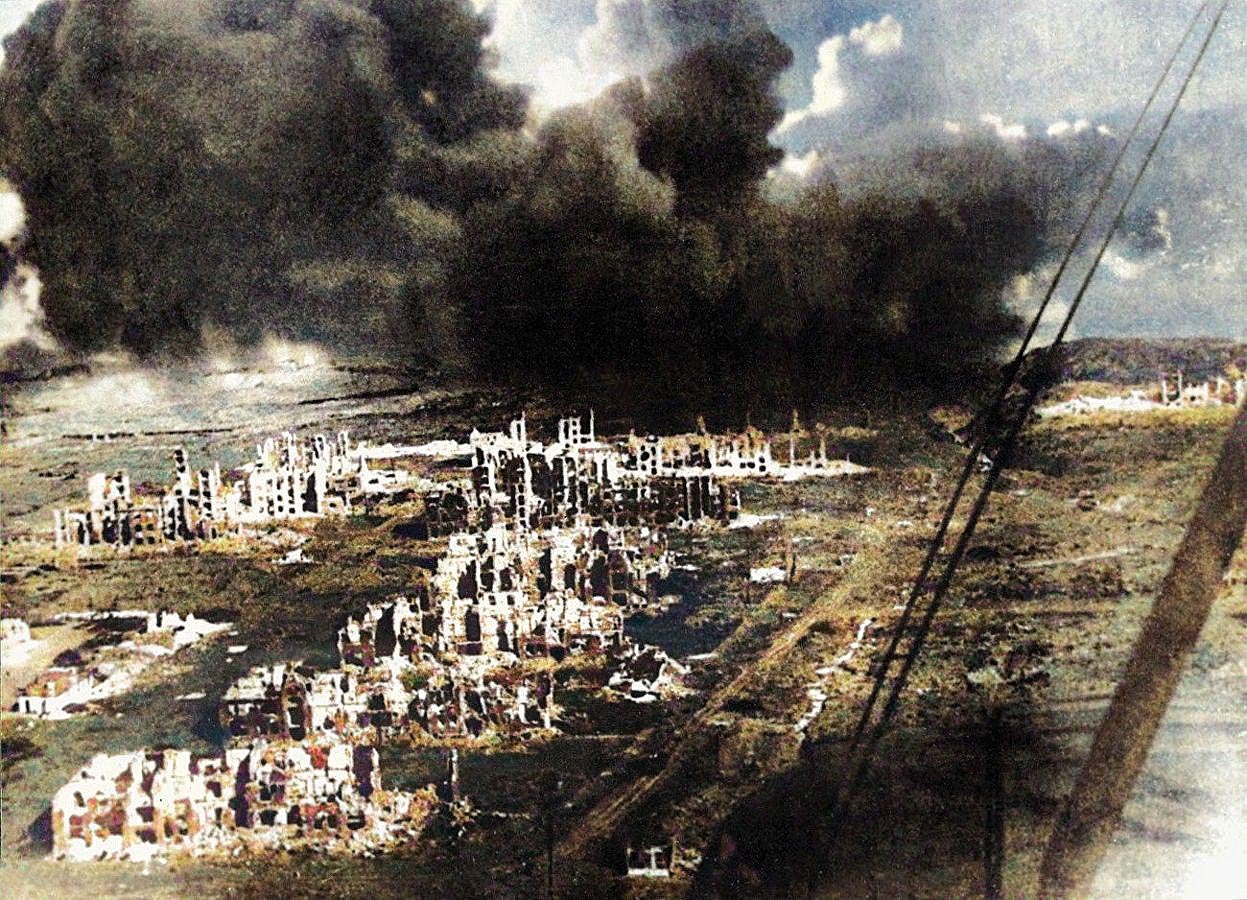
The day of August 23 became a real apocalypse for Stalingrad. Everything was on fire; transportation stopped, and the water supply throughout the city burst. The population tried to take cover in basements. The defense continuously fired at the aviation. Shrapnel rained down and the drumming sound echoed on iron roofs.
During the day, German aviation killed 90,000 people, destroyed half of the city, and turned Stalingrad into ruins. A fire engulfed the city and turned into a fiery whirlwind, sweeping everything in its path. The temperature at the center of the fire reached 1000 °C.
What appeared before us on August 23 in Stalingrad was shocking like a heavy nightmare.
Continuously, fireball sultans from bomb explosions soared up here and there. Huge columns of flame rose to the sky in the area of oil depots. Streams of burning oil and gasoline rushed towards the Volga. The river was on fire, the steamboats in the Stalingrad roadstead burned. The asphalt of streets and squares smoldered with a foul smell. Telegraph poles flared up like matches. There was an unimaginable noise that tore apart the ears with its infernal music.
The screech of bombs falling from the height mixed with the roar of explosions, the creaking and clanking of collapsing buildings, the crackling of raging fire. People who were dying groaned, women and children cried out for help in despair.
In one day, the Nazi aviation made two thousand sorties. They bombed Stalingrad, without choosing individual targets. The only task given to aviation was to wipe the city off the face of the earth. By the end of the day, a large part of the city lay in ruins.
The attack was carried out on strategically important objects, primarily factories. The Stalingrad Tractor Factory produced and repaired tanks. The Red October Factory produced metal, while the Barricades Factory produced artillery. During the raid, a large part of the workshops at all three factories was destroyed. It was impossible to extinguish the fire that engulfed the factories: the water supply was also destroyed, and the Volga was on fire due to spilled oil.
By a miracle, the enemy’s onslaught was held back. On that day, the Germans could not break through the city’s defense and stopped several kilometers away from the tractor factory. The army, militia, volunteers, and surviving residents of the city began to prepare for the defense of Stalingrad.
The ruins of buildings turned into shelters and firing points. The factories worked even during air raids, day and night, in shifts. Repaired tanks were immediately sent back into battle. Often they were repaired right on the battlefield, and in case a soldier was injured, the repairmen themselves climbed into the tank and led it into the attack.
Incredibly, after the devastating bombing, the first assault on Stalingrad was repelled.
However, the Nazi army was determined to capture the city. The battle was just beginning, and besides strategically important heights such as Mamaev Kurgan, the enemy sought to capture sources of equipment and weapons. Therefore, the next assault on Stalingrad began with the factories.
Tractor factory
Henry Ford initially wanted to build the Stalingrad Tractor Factory, but after lengthy negotiations, he abandoned the project out of fear that the Bolsheviks would take over the factory for the benefit of the state.
Therefore, with a delay of 4 years, the contract was decided to be concluded through an intermediary, the company Amtorg — a Soviet-American corporation founded in New York specifically for government procurement.
The project was undertaken by the American architect Albert Kahn, who was born in Germany in the small town of Rauen in the family of a Jewish rabbi. At the age of 12, Kahn’s family immigrated to Detroit, where he received education and began working in an architectural firm. Later, Kahn invented and patented a method of reinforcing concrete with steel, his method caught the interest of Ford Motor Company, and he became America’s leading designer. In 1937, he built every fifth industrial plant in the U.S., including Ford and General Motors factories.
Albert Kahn
The American architect who built the Stalingrad Tractor Factory.
Albert Kahn enthusiastically participated in the Soviet industrialization. He trained 4,000 specialists, and under his leadership, more than 500 factories were built in the USSR.
The prototype for the Stalingrad Tractor Plant — the first tractor plant in the USSR — was the International Harvester plant in Milwaukee, Wisconsin. The plant was designed and assembled in the United States, disassembled and delivered to the USSR, where it was reassembled under the direction of American engineers. The first tractor was produced in 1930, and the basis for the first model was the best tractor of that time — McCormick Deering 15/30.
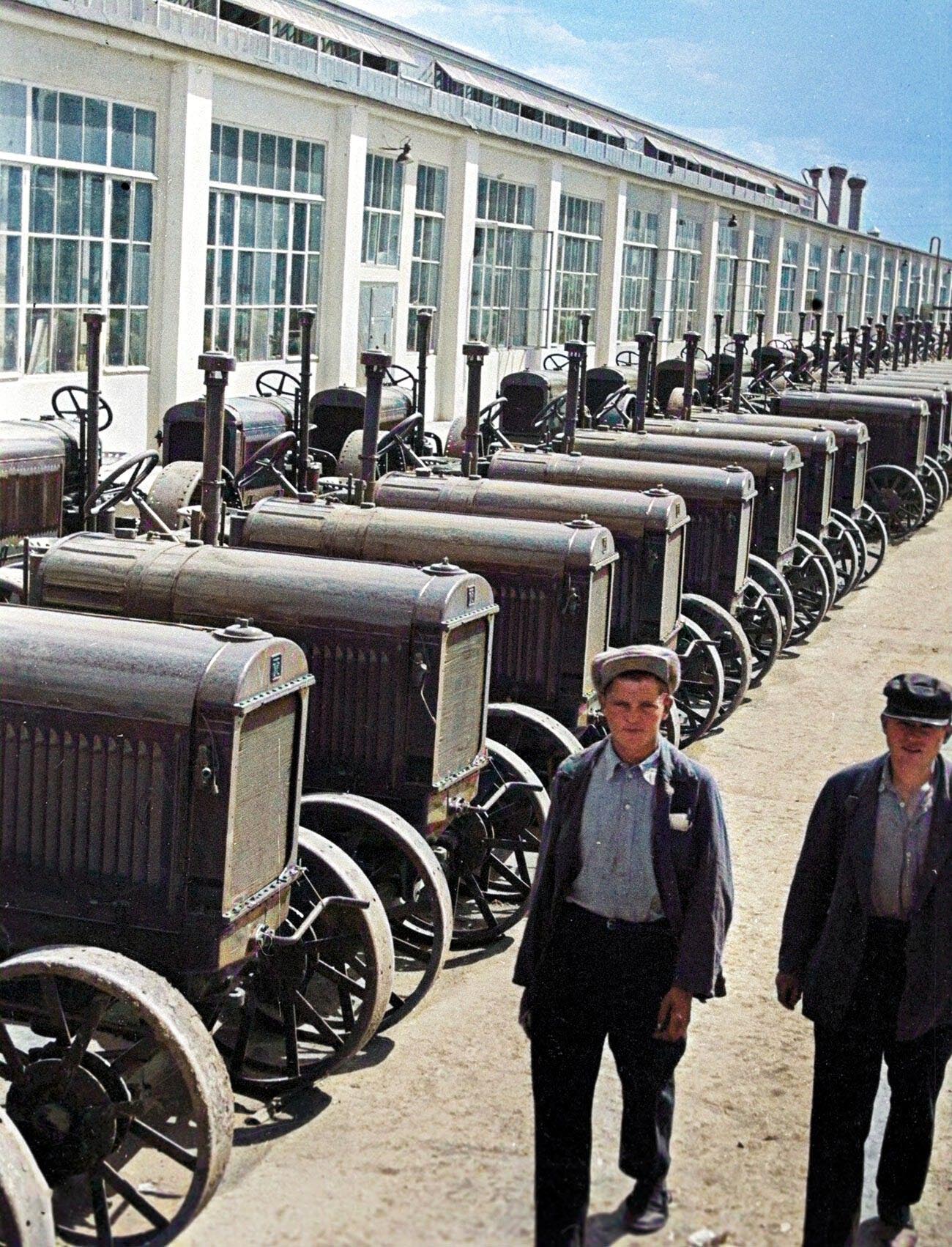
When ordering the design of the plant, the USSR set some peculiar requirements: the floors in the assembly shops had to withstand double the load. The requirements were explained by cold winters. In 1932, it became clear that the cold winter had nothing to do with it. As Ford had predicted, the contract with the Americans was terminated, and the plant was retooled to manufacture tanks. It was for them that the double-strength floors were intended.
Initially, the plant produced T-26 tanks, and in 1941, they launched production of the famous T-34. The plant produced 300 units of armored vehicles per month — as much as the entire rest of the tank industry in the country.
From the first days of the war, a popular militia was formed at the plant, which was joined by volunteers. They were ordinary people: workers, engineers, and managers. From them, a fighter battalion, tank brigade, medical and construction units were assembled. Tens of thousands of people defended the plant.
The assault on Stalingrad began on the day of August 23. At night, the factory workers went to defend the city. The fighter and tank battalions were joined by hastily formed squads of 600 people. The factory workers became tankers, mortar gunners, and riflemen. The factory itself continued to operate despite constant shelling.
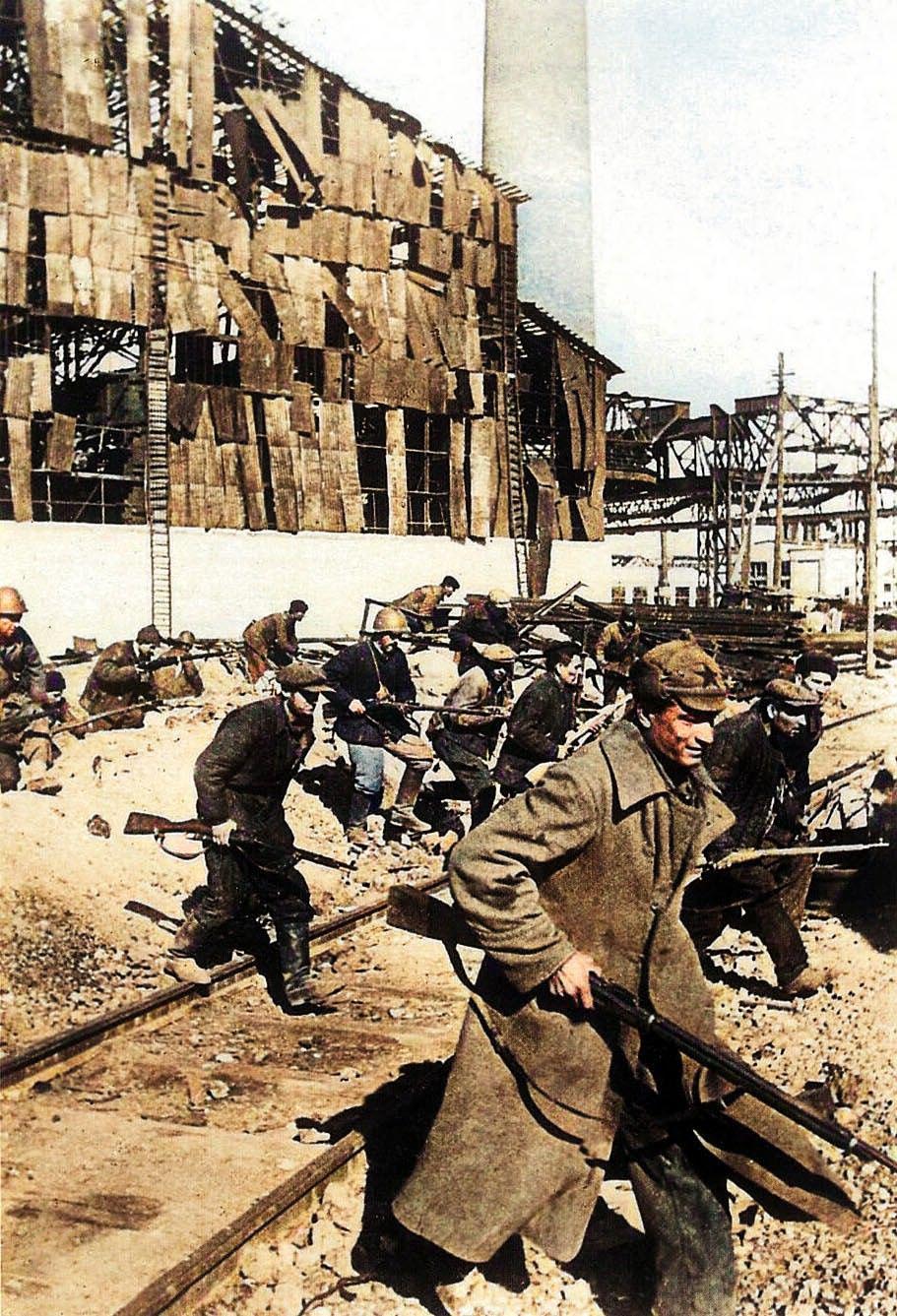
The people at the factory worked with full dedication, for two shifts in a row. They had only 4 hours left for sleep per day. Many did not leave the workshops for several days in a row. Beds and cots were moved into the workshops and work offices.
The enemy took the city by storm. Hundreds of tanks surrounded Stalingrad. Bombing from the air continued relentlessly. The anti-aircraft defense was breached. High-explosive and incendiary bombs fell on residential areas, factories, and train stations. The city began to burn. Transportation stopped, and the water supply system was out of order. The population took cover in shelters and basements of buildings. The anti-aircraft fire was so dense that shell fragments hit roofs like a jackhammer.
The attack on Stalingrad could be compared to a locust invasion. The enemy unleashed all its forces to destroy the city. A wall was advancing towards Stalingrad, destroying everything in its path.
Then something went wrong. The enemy’s advance, which was swift at first, gradually began to slow down, as if stuck in a swamp. Having covered hundreds of kilometers in the previous days, the army of the Third Reich stopped one and a half kilometers away from the tractor plant.
The further course of events is reminiscent of a dream — more precisely, the type of dream where you cannot take a step because your legs get stuck and refuse to obey. The Germans experienced something similar during the offensive. The pathetic one and a half kilometers did not give in to the enemy for almost 3 weeks! Only on September 13 did the fighting begin on the factory grounds. On the same day — and only then — was its operation stopped.
The enemy needed another month to launch a decisive offensive. On October 15, the Germans finally captured the tractor plant and reached the Volga. But decisive does not mean final. What happened next? Let’s hear from the German side, which cannot be suspected of sympathies for the USSR:
In mid-October, the largest operation at that time began: an offensive by several divisions, including tank divisions, on the Stalingrad Tractor Plant.
Reinforcements were being brought to us in Stalingrad from all fronts. Five engineer battalions were airdropped into the battle area from Germany. The 8th Air Corps provided full support for the offensive. The advancing troops moved two kilometers forward, but could not completely overcome the resistance of three Russian divisions defending the plant and capture the steep bank of the Volga.
If our troops were able to reach the bank during the day on some parts of the front, at night they were forced to retreat again because Russian forces entrenched in ravines cut them off from behind.
The tractor plant did not stop working even during the “decisive offensive” of the Germans.
Tank assembly and repair continued at the plant. Tanks damaged on the battlefield were brought to the plant, where workers immediately surrounded them. There was also a place for heroism. Factory worker Petr Korchagin did not leave the T-34 tank for three days, which was so damaged that it was only suitable for smelting. Korchagin managed to repair the tank, essentially recreating it from scratch. As soon as the Germans began to approach the workshop, Korchagin himself climbed into the tank and led it into battle.
The assembly workshop was defended by a group of 57 riflemen, who were nicknamed the “57 Immortals”. For nine days, the soldiers defended the workshop where tanks were being repaired. Hitler’s assault battalions attacked the factory up to 5 times a day, but all attempts were unsuccessful. Even when only 6 people were left in the group, German generals continued to believe that the defense was being held by an entire division.
The fascists launched a decisive attack on the tractor factory, and the commander transferred us there. On October 14, the most memorable battle of the great war began. We defended Dzerzhinsky Square. One hundred tanks rushed towards us, as did fighters. Kolya Smorodin’s gun was destroyed, but he miraculously survived and continued to fire from an armor-piercing gun. Ruins, asphalt, and earth were set ablaze. More than half of our soldiers died, but the enemy lost two dozen tanks and could not break the resistance of a handful of our fighters. They flanked the factory...
We broke through into the burning workshops and once again engaged in battle with the tanks. And then 57 wounded, burned soldiers united and took up defense on the edge of the Volga cliff. Under the precipice, next to the Volga, was the entire stockpile of ammunition, and this was the last deadly frontier.
Nikolai Smorodin and three soldiers with automatic rifles took a bag of grenades and caused havoc in the enemy unit’s position. The panicked enemies retreated, and at night we mined our last edge near the precipice. When there were only six of us left, Smorodin disabled three tanks, aimed at the fourth, but then he was stunned by a projectile. Kolya clung to the edge of the cliff, his weakened body slipping. That was the last thing I saw because I was badly wounded too.
Alexey Ochkin
A war hero, participant of the Battle of Stalingrad and the storming of Berlin. A writer and a director. Nicknamed “Lieutenant Fire”.
Group commander Alexey Ochkin was wounded in the head, lost consciousness, and became blind. His comrades tied him to a wooden raft and sent it across the Volga, which was burning with spilled oil. Ochkin was noticed on the other bank and rescued. He regained his sight in the hospital and soon returned to the front.
During the fighting, several thousand bombs were dropped on the factory’s territory. The plant was almost completely destroyed. It was only restored in 1945, but this did not prevent the tanks from being repaired in 1943, in makeshift workshops and even on the streets. After the war, the factory produced tractors and military equipment and successfully operated for many decades.
Only in 2018, the factory became bankrupt and was closed. Now the plant is completely destroyed. Only the entrance gate remains, behind which there are only ruins. It seems like the war was just yesterday.
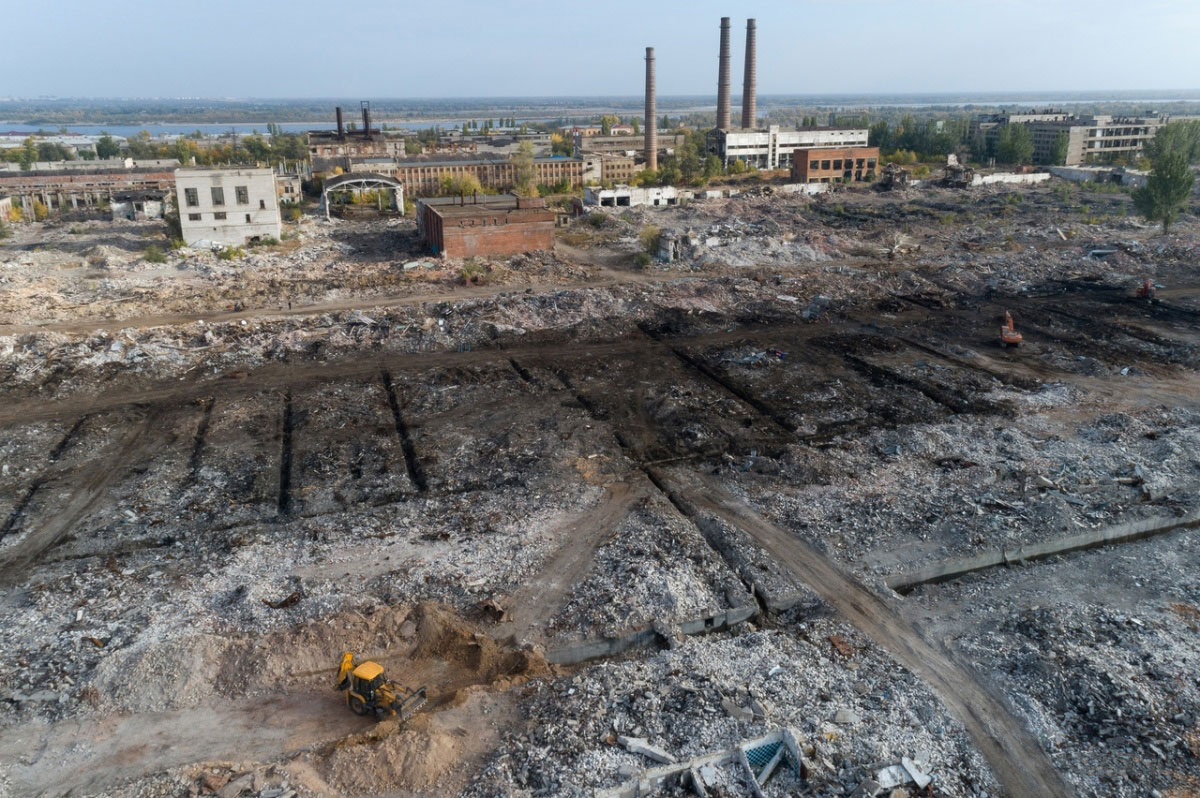
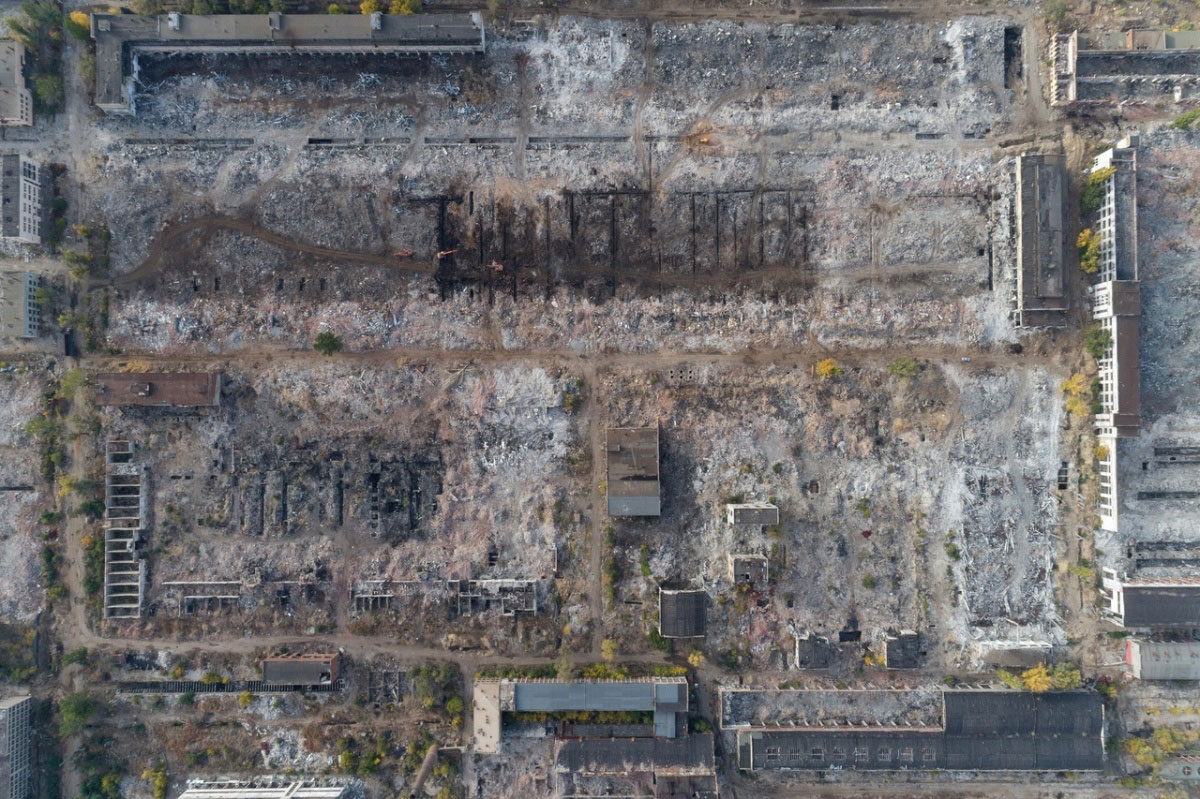
Red October
The Stalingrad “Red October” factory did not produce candy. The name of the plant was given after the revolution, but it was founded in 1897 by a French company and was called “Ural-Volga”. It is a metallurgical plant that in 1941 produced 9% of all steel in the USSR. Therefore, it was strategically important for the Germans to disable it.
On the day of the attack, August 23, the bombing damaged the Martin furnaces used to melt steel at “Red October”. On the same day, the factory workers took up arms.
Throughout August, the workers held their defense. Battles began on the factory’s territory. In September, the Germans launched an offensive. The attacking forces greatly outnumbered the defenders, but the enemy was unable to crush the resistance.
The defense held out for two months and only fell on October 22. The defense battalions were exhausted. The last remaining battalion — a training one — was sent to fight the enemy. By the morning of October 23, the enemy was pushed out of the factory’s territory, only to break through again in the evening, already from the north, seizing the laboratory. The breakthrough was repelled again at night, and the Germans were pushed out of the laboratory but remained on the factory’s territory.
The next day, two German battalions supported by seventeen tanks launched an assault on the entrance gate of the factory. The weak defense collapsed, breaking down into separate and chaotic battles that spilled over onto the factory’s territory.
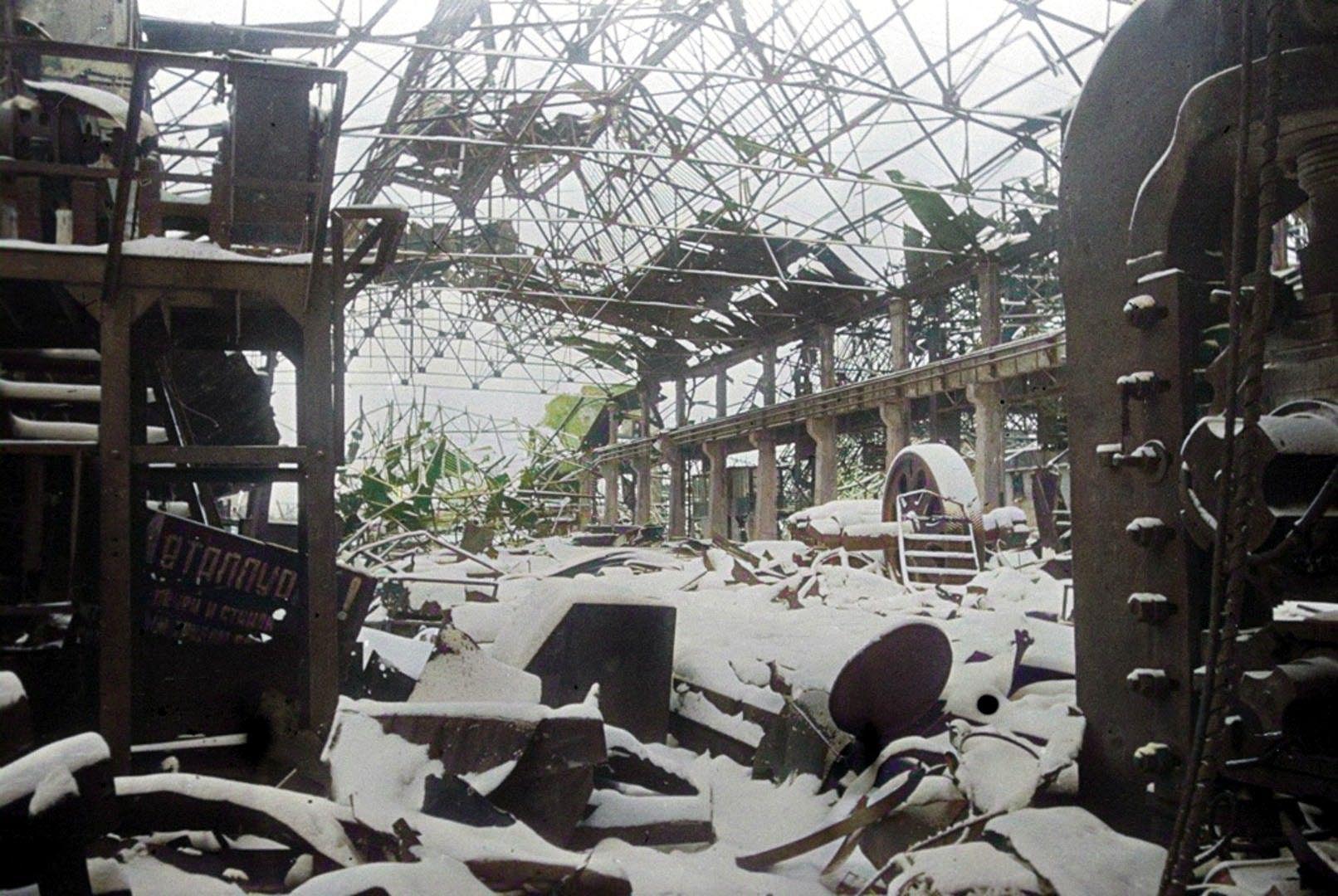
A day later, the Germans captured the Martin workshop, but only to return it to the hands of the defenders at night. When the battles moved to other workshops, everyone was involved in the defense, including signalmen and a musician platoon.
This bloody mess lasted for over two weeks. Pieces of the factory changed hands endlessly, several times a day. The chaos ended only on November 11 when a truly massive German offensive finally overwhelmed the defense. Soviet soldiers were thrown back to the banks of the Volga.
The factory remained in enemy hands until mid-December when it was stormed by a Guards Rifle Regiment. By the end of December, the factory had been recaptured, the enemy was defeated, and the Battle of Stalingrad began to wind down.
Six months later, in the summer of 1943, the factory resumed its operations. By the end of the USSR, the plant accounted for 12% of all steel production in the Soviet Union.
Like the tractor plant, “Krasny Oktyabr” survived the war and the collapse of the Soviet Union, but it did not withstand the country’s degradation under Putin. In March 2019, the factory went bankrupt. Its operations still continue, but for how long?
Barricades
The “Barricades” plant was started to be built even before the revolution, in 1914. The reason for its construction was the Russo-Japanese War, during which the Russian Empire lost many warships. Modern artillery was required for new ships, so an agreement was reached with the British company Vickers to build a factory named the “Tsaritsyn Artillery Plant”.
During World War I, the plant produced artillery guns, repaired armored trains, and was the largest enterprise in Europe, but the revolution disrupted the factory’s work. It received further development only after the revolution under Soviet power. During World War II, the plant produced artillery: guns, mortars, and howitzers, up to a thousand per month.
Before the start of the Battle of Stalingrad, almost all of the factory’s personnel were evacuated to Siberia, Kazakhstan, and the Urals. The remaining workers defended the plant during the battles. Only after enduring the devastating bombing on August 23-24, did the factory workers return to their machines.
The power station that provided electricity to the factory was disabled by bombing. It took three days to restore it, and during that time people worked manually. The station was restored and worked until September 27 when a direct hit from a bomb destroyed the last turbine generator. During this time, the plant managed to produce so many guns that it provided several artillery regiments. People worked in two shifts and slept at their workstations.
During the October battles for the Barricades, there was a communications breakdown. The command twice sent signalmen to restore the broken wires, but each time unsuccessfully. Sergeant Matvey Putilov accomplished this heroic feat and successfully completed the task.
When Putilov was breaking through to the broken wires, he was wounded in the shoulder by a mine fragment. Overcoming the pain, Putilov crawled to the break point. At that moment, a second attack shattered his hand. Losing consciousness and unable to twist the wires with his hands, Putilov put them in his mouth and bit down, allowing the current to pass through his body. The communication was restored. They found Matvey Putilov dead, with the wires clenched in his teeth.
Matvey Putilov
War hero, sergeant, commander of a signal platoon.
After the Battle of Stalingrad, the Barricades plant was almost completely destroyed. The area around the plant was heavily mined by the Germans, so before restoration could begin, extensive demining operations and removal of rubble had to be carried out.
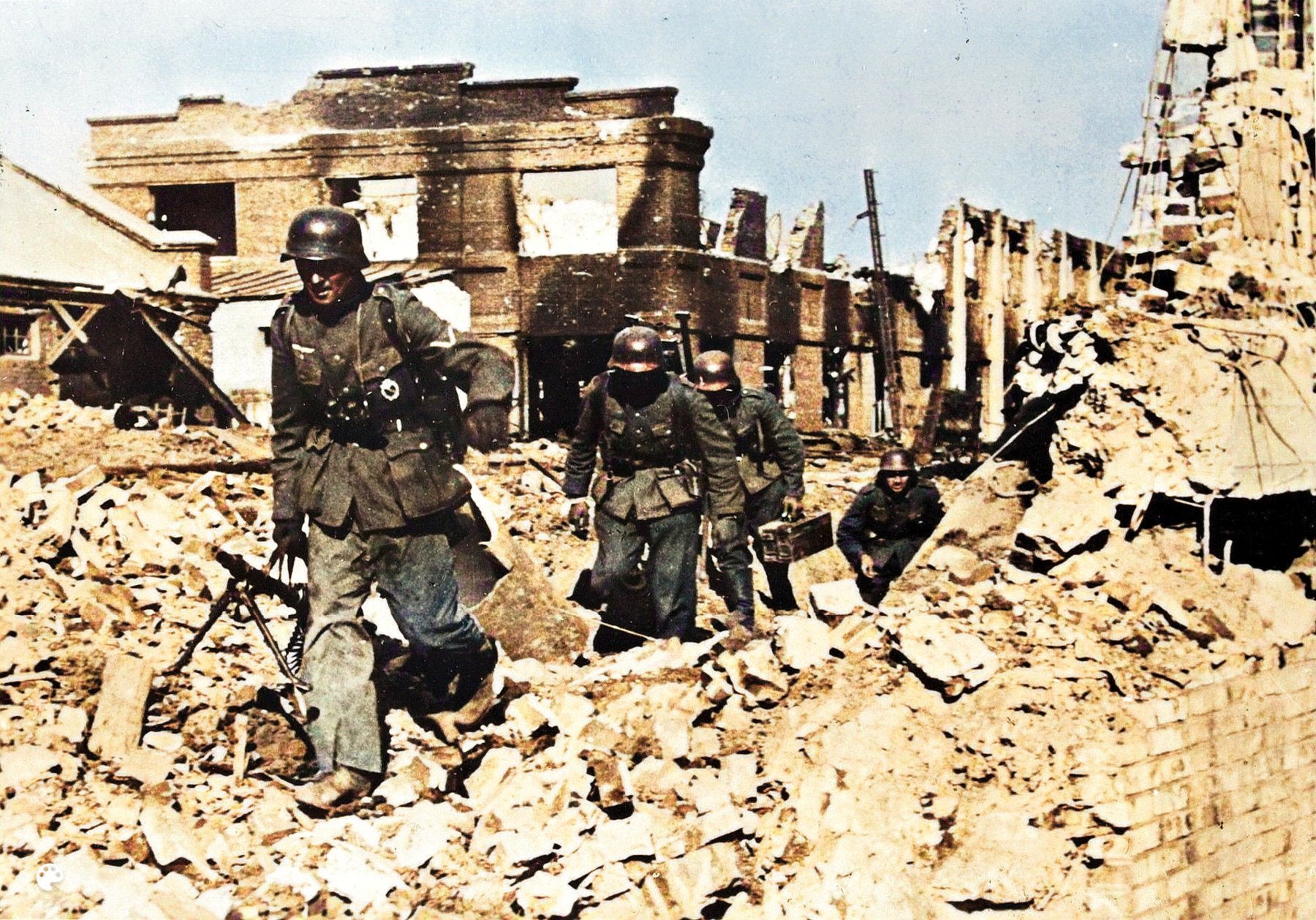
The plant resumed operations six months after the battles ended, in July 1943. By the end of the war, the factory had already been restored and production plans were exceeded by twofold. After the war, the plant produced hulls for nuclear reactors for icebreakers and submarines.
In 1963, the Barricades factory began producing children’s strollers, toys, and cigarette cases, and in the 1980s — the Ivoga washing machines, based on Japanese models. After the collapse of the Soviet Union, the plant produced components for missile systems such as Iskander-M, Topol, and Bulava.
The factory is still operating, but not for long. Some of the workshops have already been sold to the Red October plant. They are currently shut down and the windows are broken.
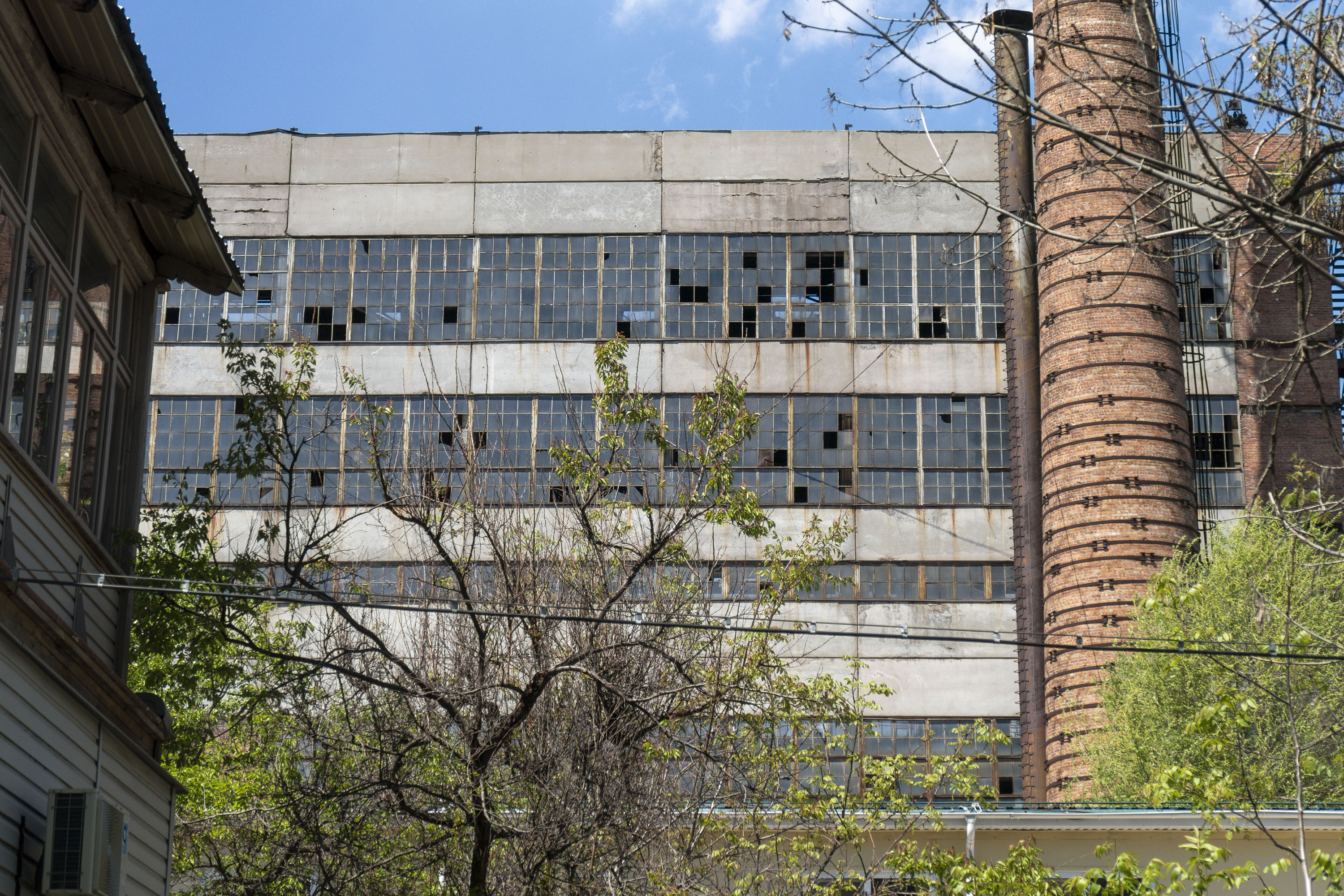
In recent years, massive layoffs have begun at the Barricades plant, and the factory’s assets are slowly being sold off at auction. Most likely, the company will declare bankruptcy in the near future, and the century-long history of another victorious factory will come to an end in new Russia.
Lyudnikov Island
On October 14th, division commander Ivan Lyudnikov received an order to raise one regiment on alert and ferry it across to the western bank of the Volga. Two days later, a second order was received: to occupy and firmly defend the line, not allowing the enemy to advance towards the Barricades plant area.
Ivan Ludnikov
Hero of the Soviet Union, Colonel General. He held the defense of “Lyudnikov Island” for a hundred days while surrounded by the enemy.
After crossing the Volga, Lyudnikov’s division positioned itself along the river in a narrow 700-meter strip right behind the Barricades plant. The defensive sector extended only 400 meters into the city. The command post was located in an old brick building where the factory director had lived before the revolution.
From the very beginning, it was clear that the division was heading towards death: the Germans had almost reached the Volga by then. The soldiers were surrounded from the city side; behind them was the river. Enemy divisions couldn’t take the factory by storm and began to bypass it from the north. The front line weaved like a serpent, passing between individual buildings, diving between garages and warehouses. Factory workshops and facilities changed hands several times a day. The enemy slowly but steadily infiltrated the Barricades' territory.
Hitler’s troops launched a decisive attack on the Barricades on November 10th. In two days, the Nazis were able to capture the factory territory and reached the Volga over a 500-meter stretch.
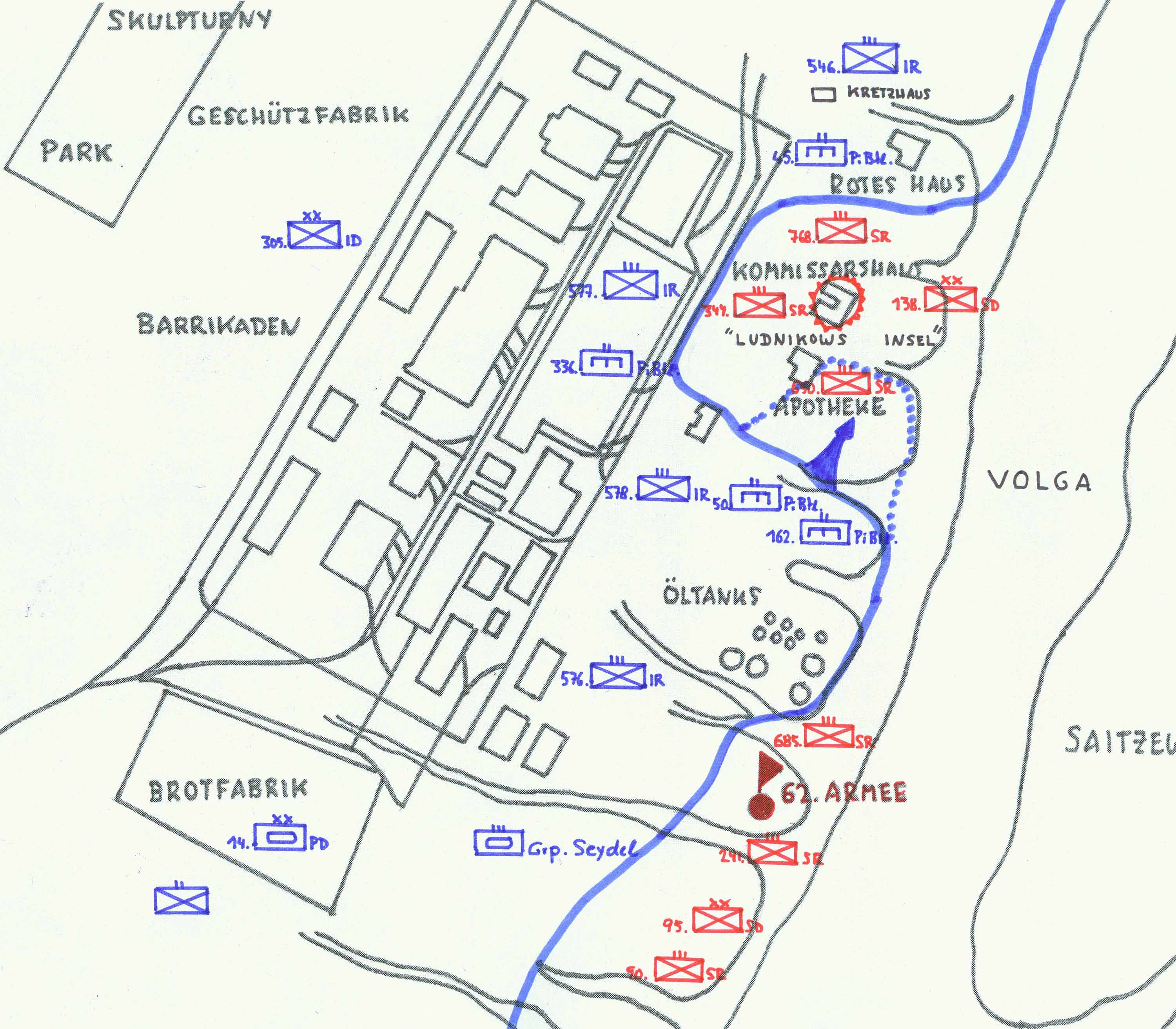
Lyudnikov’s division found itself trapped by German forces on three sides, with the Volga to the fourth side. The division was supplied with food and ammunition only across the Volga, at great cost due to constant attacks.
Finally, in December, the Volga froze solid. An artillery battalion came to the rescue and took up defensive positions, preventing Lyudnikov’s division from being completely surrounded. On December 14th, the exhausted soldiers who had been facing superior enemy forces for two months launched an attack. Within a week, the division’s regiments advanced 200 meters forward and linked up with another division. The Lyudnikov’s soldiers held out and emerged victorious, breaking through the encirclement.
The small strip of land that the soldiers defended is called “Lyudnikov Island”. A memorial complex is located here, with the main attraction being the destroyed command post.
This is one of three buildings in Stalingrad that has been left untouched since the war. This is how the soldiers of Lyudnikov’s division left it when they retreated in October 1942.
Gerhardt\’s Mill
The second building is Gerhardt’s Mill.
Gerhardt’s Mill is a steam mill building constructed in 1908 by an entrepreneur named Gerhardt.
In fact, the mill was not only used for milling flour, but also for smoking fish, whipping butter, baking bread, and storing produce. The mill was modern for its time: it operated from an independent power source, had its own boiler room, and mechanical conveyors.
The mill looks like it was built of bricks, but in fact, it was not: the brick was just a facing for a reinforced concrete frame — the latest technology at the time. Thanks to the reliable design, the building survived during the war.
With the arrival of Soviet power, the mill was nationalized and renamed to Grudinin’s Mill — in honor of the Communist Party secretary who worked at the mill as a lathe operator and was killed during the Civil War. Gerhardt, on the other hand, was arrested by the NKVD in 1933 and died in prison four months later.
The mill ceased operations on September 14th, 1942, when it was hit by explosive bombs. The building suffered serious damage in September, but it held up. The shattered mill became a strongpoint for many divisions defending Stalingrad. Throughout the battle, infantry divisions and battalions would occupy and then lose positions at Gerhardt’s Mill after a few days. The mill was an important height from where the entire area could be seen.
The mill was surrounded for two months. During this time, dozens of aerial bombs, shells, and mines hit the building. One bomb penetrated the roof of the mill, and the walls were destroyed by shells. The walls of the mill are riddled with bullets and shrapnel.
It was decided to leave the mill in the condition in which it survived the war. It is an outstanding monument of the war, surpassing in expressiveness all monuments and obelisks taken together. Before your eyes is frozen history.
Pavlov\’s House
Gergardt’s Mill is often confused with Pavlov’s House. This is the most legendary house in Stalingrad. A hero house in a hero city.
The house was built in the mid-1930s. It was not yet called “Pavlov’s House” at that time. It was an ordinary four-story residential building with four entrances. It was located in a prestigious area of Stalingrad, and party workers and industrial specialists lived in the house.
In mid-September, the Germans were advancing towards the Volga near Gergardt’s Mill. Opposite the mill, where the regimental command post was located, was Pavlov’s House. Another similar house stood next to it.
The headquarters ordered to use these four-story houses as strongholds for the rifle division. Two groups of fighters were sent to defend the houses, one of which was led by Sergeant Yakov Pavlov, and the other by Lieutenant Nikolai Zabolotny. Both groups completed the task and repelled the Germans from the houses.
Initially, Pavlov’s group consisted of him and three fighters. Reinforcements arrived after three days: a machine-gun platoon, anti-tank gunners, and automatic riflemen — 20 people in total. Pavlov’s small group defended the house for 58 days. During this time, the house was not surrendered to the enemy and withstood dozens of attacks and bombings.
Yakov Pavlov
Hero of the Soviet Union, Senior Lieutenant. Commander of the group of fighters who held the defense of “Pavlov’s House”.
The German tactics were based on close cooperation between all branches of the military. Infantry, artillery, sappers, and bombers constantly communicated with each other using a developed communication network. Soviet troops were worse equipped and did not have a corresponding tactic, but during the war, they found a very risky gap in the German tactical system.
Soviet fighters realized that if they approached the enemy close enough, they could paralyze the German aviation and artillery: they would simply start hitting their own. And then the Germans had only one way out: man to man combat. Rifles, grenades, knives, and hand-to-hand combat came into play. The fight began not just for life but for death. Fighters faced the enemy face to face, separated by a dozen meters, a couple of staircases, an entrance, or a street. The struggle was not only for every street and plant but for every house, entrance, floor, and bench.
Fighting heroically for Pavlov’s House, machine-gun squad leader Ilya Voronov received 25 wounds. Bleeding heavily, he tore off the grenade rings with his teeth and threw them into the thick of the enemy. Nineteen-year-old sniper Anatoly Chekhov destroyed 200 Germans, for which he was awarded the Order of the Red Banner right on the battlefield. When the Germans destroyed one of the walls of the house during the bombing, the fighters laughed: “We still have three left.”
The German assault planes could not capture this house. The enemy only managed to repel the first floor, and then they could not advance any further. Only three defenders of the house were killed. The number of Germans killed must be in the thousands.
Pavlov himself was wounded in the leg and was hospitalized. Later he became a spotter and reconnaissance commander. After the war, Pavlov was awarded the title of Hero of the Soviet Union, but the memory of the feat of his group was best preserved in Stalingrad. The house that Pavlov’s group defended was restored after the war and named in his honor. Nowadays, Pavlov’s House is in excellent condition, and people live in it.
On one of the walls of Pavlov’s House, after the war, an inscription was made: “This house was defended by Yakov Pavlov”. During the reconstruction of Stalingrad, the house was rebuilt, and in memory of the war, an imitation of an old brick wall was laid. Similar inscriptions were carved on it, but they were not as beautiful as the post-war ones.
Another wall, which was damaged during bombing, is connected in the modern version of the Pavlov’s house with a huge bas-relief that adjoins the memorial colonnade.
The second house, which was defended by Lieutenant Zabolotny, was completely destroyed by the Germans. Zabolotny died, as did almost all of his platoon.
Elevator
On the outskirts of Stalingrad, a huge industrial building is visible. It consists of a row of columns tightly connected to each other and a high annex with windows. This is a grain elevator. It was designed by the All-Union Trust Bread-building and launched in 1941.
The Stalingrad elevator was the tallest structure in the city and of interest in the Battle of Stalingrad. The elevator was a dominant height from which the entire city could be observed. It was strategically important for German troops to capture the elevator.
German units entered the area of the elevator on September 14. The enemy forces outnumbered the defense. By September 19, they managed to surround the elevator from three sides. On that day, there were two attacks on the elevator with the support of seven tanks, which ended up with more than 30 soldiers and officers being lost for the Germans.
Then the battles for the elevator dragged on. Although approaches to the elevator were blocked by the Germans, the defense had decent reserves of ammunition and food. Therefore, all attempts by the Germans to capture the elevator were met with rifle fire. Then General Werner Kempf, the commander of the German division, ordered an attack on the elevator with anti-aircraft fire.
The German tank division fired at the elevator 50 times, hitting it 44 times. The walls of the elevator were pierced, but the wall could not be brought down. It created the impression that the elevator had suffered no damage. In reality, this was not the case. Inside the building, fragments, pieces of concrete and reinforcement flying around mutilated dozens of Soviet soldiers.
After the shelling, the Germans tried to take the elevator again, but the defenders regained their composure and threw grenades at the German infantry from the upper floors. Then the Germans attacked the elevator with howitzers and finally collapsed one of the walls. After this, a delay occurred, allowing the defense to wait for reinforcements.
After several attacks on the elevator, the defense ran out of ammunition and food. Understanding the desperate situation, the soldiers decided to break through. At night, they eliminated the guards and literally over the heads of sleeping Germans, shooting and demolishing everything in their path, they made it to the Volga River. On September 22, the Germans captured the elevator. 104 Soviet soldiers surrendered.
The liberation battles for the elevator began in January 1943. The building became a stronghold for German units. The enemy shelled the Soviet army with artillery and mortars. The elevator was stormed on January 27. Survivors of the artillery regiment surrendered.
The elevator still operates and is recognized as a cultural heritage object.
Stalingrad-1 railway station
The first railway was laid in Tsaritsyn back in 1862, and a wooden station was built at the same time. Eight years later, the second railway was built, and the building was replaced with a brick one. Under the Bolsheviks, in 1931, the second floor and the right wing were completed.
The first attack on the railway station — one of the most important strategic objects in Stalingrad — was carried out by the Germans on August 23, 1942. On that same day, the war correspondent Emmanuel Evzerikhin took one of the most famous photographs of World War II. It was called: “August 23, 1942. After a massive raid by the Hitlerite aviation.”
The photograph captured a fountain with dancing children who surrounded a crocodile against the backdrop of burning buildings. The scene with the children was taken from Korney Chukovsky’s fairy tale “Barmaley”, which is why the fountain entered history under the name “Barmaley”.
Dancing, playing around the fire:
“You,
You
Saved us from death,
You have set us free.
In good time
You saw us,
O good
Crocodile!”
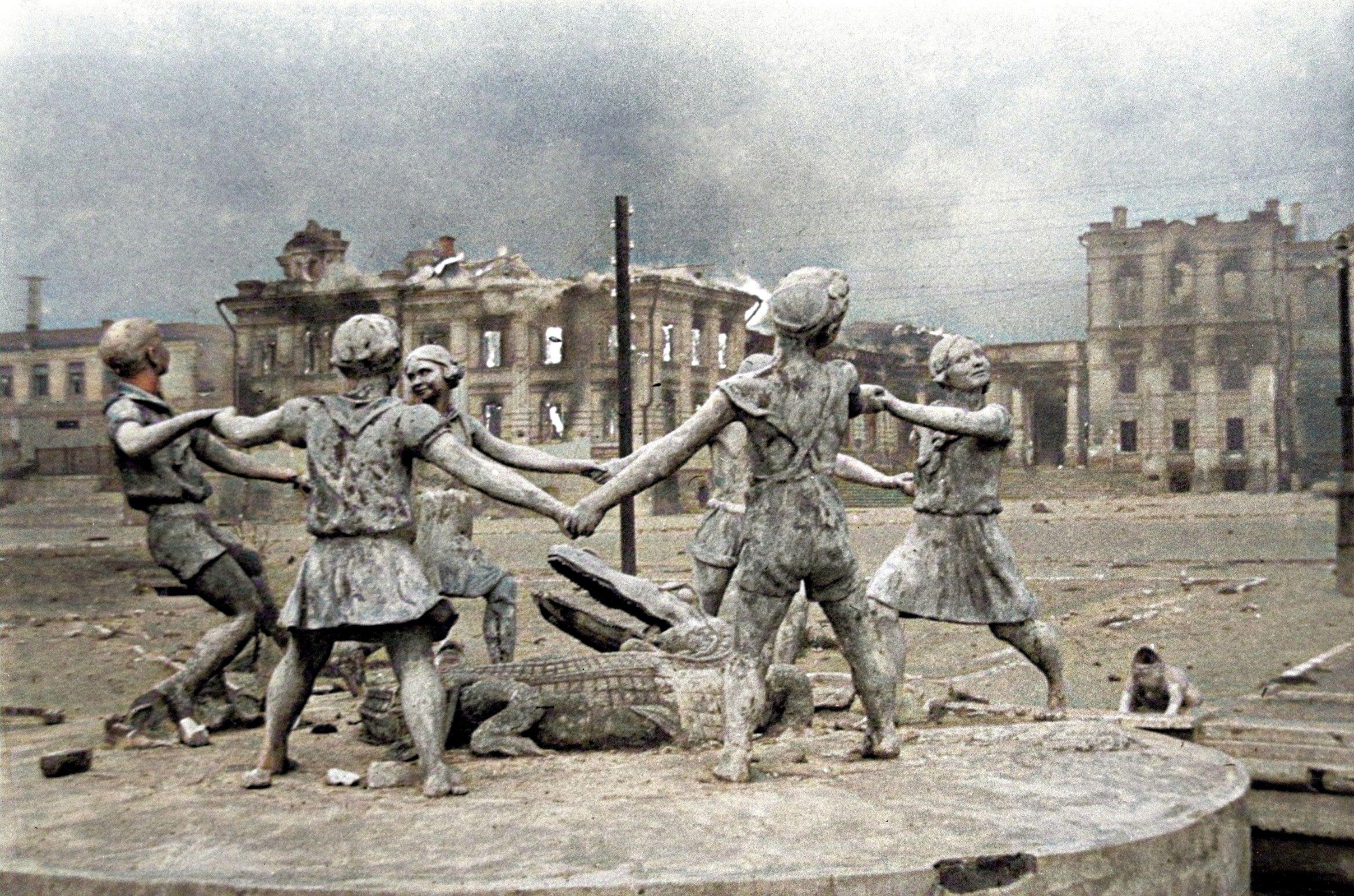
The German offensive was underway. On September 14, 1942, an order was received to ferry the division across the Volga. The first to depart was the battalion commanded by Senior Lieutenant Zakhar Chervyakov.
According to the order, Chervyakov was supposed to determine the German defense positions and mark them with rockets so that artillery from the other side of the river could attack the enemy. The battalion was noticed during the crossing. The Germans opened fire, sinking one boat and killing several dozen people, but the battalion managed to land.
Next, the unimaginable happened: instead of following the order to take positions and mark the German defense, Chervyakov’s battalion struck straight at the enemy. The battalion crushed the enemy’s defense and broke through to the center of Stalingrad, to the train station, in a matter of hours.
It became known later what had happened. Chervyakov received information that the Germans had managed to break through the Soviet defense in the area of the train station. Urgent reinforcement was needed, otherwise the enemy would capture the strategically important station. Chervyakov’s breakthrough was so unexpected and swift that neither side had time to understand anything.
The company of machine gunners stormed the train station building. The attack was so sudden that the Germans fled in fear. By morning, the station had been cleared of the enemy, but Chervyakov’s battalion lost a third of its soldiers. Here is how a participant of the battle describes the assault:
Anton Dragan
War hero, Lieutenant. Participant in the battles in Stalingrad, including for the train station and the city center.
The fighting for the train station continued — it was too important a target for the Germans to just give up. The fighting lasted for two days and eventually moved to the square in front of the station. The clash took place near the fountain. The gunfire was so intense that the battalion almost ran out of ammunition, and there were many wounded. Then the battle moved into the building of a nail factory near the station.
In the following days, the Germans blew up the wall of the factory where Chervyakov’s soldiers had taken shelter. Grenades rained down on them. The battalion held on with their last strength. The soldiers picked up the grenades thrown at them and threw them back at the Germans through the window.
Several more days of endless fighting for the train station passed. Finally, on September 21st, the defense of a single company became too much for the Germans, who seemed to be fighting against a whole army. The enemy launched a mad attack with tank and artillery support. All the forces available to the Germans were committed. The battle turned into a meat grinder. By midday, the enemy had split Chervyakov’s battalion into two parts.
The remnants of the battalion by the train station continued to fight, but the German attack was too strong, so the defense slowly retreated towards the Volga. The company commander Anton Dragan used the same tactics as Pavlov: he fought very close to the German troops so that artillery and aviation could not intervene.
By that time, the train station had been heavily damaged.
In one day, the Germans advanced two blocks. Dragan’s soldiers occupied some house where they broke a part of the brick wall. They threw bricks, stones, and beams at the attacking Germans. A place for the wounded was arranged in the basement. The fascists attacked the house continuously for five days. The remnants of the battalion, which numbered forty people, were reduced to twelve. There was no water. Only a few kilograms of burnt grain remained for food.
One night, an event occurred that was much more dramatic than all the failures and defeats: a coward was discovered among the soldiers. One of the lieutenants committed treason and fled with a private, crossing the Volga. The private was shot and killed. Here is how they describe the encounter with the surviving lieutenant:
Meanwhile, thinking that the remnants of the battalion had run out of ammunition, the Germans became brazen and started to emerge from their cover standing upright. They marched in a column along the street and were loudly shouting.
Then I loaded the last belt into the machine gun mounted at the half-basement window and put all two hundred and fifty rounds into the screaming, dirty-grey fascist crowd. I was wounded in the hand, but did not drop the machine gun. Piles of corpses covered the ground. The surviving Nazis panicked and fled to their shelters. An hour later, they brought our tank destroyer to a pile of rubble and shot him in front of our eyes for showing them the way under fire from my machine gun.
The attacks stopped, and in their place came a downpour of shells and mines on the house. The fascists fired from all kinds of weapons. The sound of tank engines was heard, and the guards decided that their fate was sealed. A messenger took a Finnish knife in his hand and wrote on the wall: “Here fought for the Motherland and died the guards of Rodimtsev.”
There was a salvo. The house trembled and collapsed.
I don’t remember how much time passed before I came to. It was dark. Acrid brick dust hung in the air. Muffled groans could be heard nearby. The messenger Kozhushko, who had crawled up to me, was shaking me:
“You’re alive.”
Having crawled out of the brick tombs where they had been buried alive, by the morning of the next day, the guards broke through to the Volga and reached an anti-aircraft battery, where they were fed and given medical assistance.
By the end of the battle, little remained of the train station. The legendary fountain survived but was dismantled in 1951. An unskilled copy made of cheap plastic filled with foam was installed in 2013 and managed to rust within a month. The copy differs significantly from the original, which did not survive.
The second part of Chervyakov’s battalion, after being cut off, was thrown into the area near the city department store, where it was surrounded and fought its last battle.
Department store
The Central Department Store of Stalingrad was a magnificent building in the neoclassical style; it was built just before the war in 1938. The department store had five floors, and the facade was rounded, which made the building fit perfectly into the city center.
After the Germans split Chervyakov’s battalion on September 21st, the second part retreated to the city center, to the department store. With this part, the battalion’s command staff found themselves, led by Senior Lieutenant Fedor Fedoseev.
The group was cut off by the Germans and took positions in the department store. Anton Dragan, who was defending the train station at the time, fought with all his might. There was nowhere to evacuate the wounded, and messengers sent to headquarters did not return. Communication between the platoons was severed. It was thought that Fedoseyev had died on the same day.
That was not the case. Short messages did come from Fedoseyev via radio for several more days. Communication finally went dead on September 25th.
Throughout this time, the fighters desperately fought against the advancing enemy. They were surrounded, deprived of supplies and water. After a few days, the Germans broke into the department store. The group’s ammunition was completely exhausted, so the soldiers rushed into hand-to-hand combat.
Fedor Fedoseev
A war hero, a lieutenant. Disappeared without a trace while bravely defending the center of Stalingrad.
Unfortunately, the enemy forces were many times greater than the defeated group of Soviet fighters. The Germans brought up tanks. The battle ended with the complete defeat of the platoon.
In October, the German headquarters took over the department store. The building was ideal for their location: a large and convenient basement, a tall structure in the center of the city, with excellent architectural style. Regiments were quartered in nearby houses. A Nazi flag was hung on the facade of the department store.
The Germans settled in well at the department store. In the basement, they set up a hospital where they treated the wounded and performed surgeries.
Of course, just like for Soviet fighters, the medicines ran out. There was a shortage of bandages, tents, winter clothes, firewood, and fuel. Doctors were exhausted and only treated those whom they could somehow save. The hopeless cases, of which there were many, were left to their fate. A cemetery for them was also set up nearby the department store — in the city park.
Here’s how a German soldier describes surgery under constant bombing:
Our operating room was in a school. Surgeons worked under artillery bombardment. Shells were exploding very close. Pieces of plaster were falling from the walls and ceiling, sometimes quite heavy ones. Everything shook from the explosions. At any moment, we could expect a direct hit.
I stood behind the doctor at the operating table and, imitating the surgeon, tried to act as if everything was going according to plan. Our medics also behaved calmly. However, when another shell exploded nearby, of course, everyone felt uneasy.
Very soon we realized that it should take six seconds from the moment of the shot to the explosion of the shell. And each of us involuntarily began to count: one, two, three, four. On “four,” the surgeon withdrew the scalpel from the wound and waited for the explosion.
Here, in the basement, in one of the rooms, the Germans organized a radio station.
Over time, all the main military leaders of the 6th Army began to gather at the department store, and it became the main German headquarters. Gradually, winter approached, bringing with it freezing temperatures. The hopes of the German soldiers for a quick capture of Stalingrad and the ideological defeat of the USSR in Stalin’s city were shattered: with the onset of winter, this became increasingly clear to more and more Hitler’s invaders.
However, it was not just the winter, but also the incredible resilience and heroism of Soviet soldiers. The army that suffered a dramatic defeat in the first year of the war learned its lesson and became invincible.
The Germans understood their defeat with their minds, but few could accept it with their hearts. The Germans couldn’t believe their defeat until the very end of the Battle of Stalingrad. People in despair start to cling to any, even the most incredible idea: such is the power of denial — a defensive reaction of the human psyche.
And so the German soldiers denied the catastrophe until the very end, inventing funny fairy tales. Here and there, rumors surfaced about a group of paratroopers capturing some important bridge, then about a whole army coming to reinforce them, or about a top-secret weapon invented by the Third Reich.
It was too difficult to admit that the encirclement of the 6th Army had taken place, and it was carried out by those Soviet “sub-humans” whom Hitler so pompously told the German nation about.
In December, Stalingrad lay in ruins.
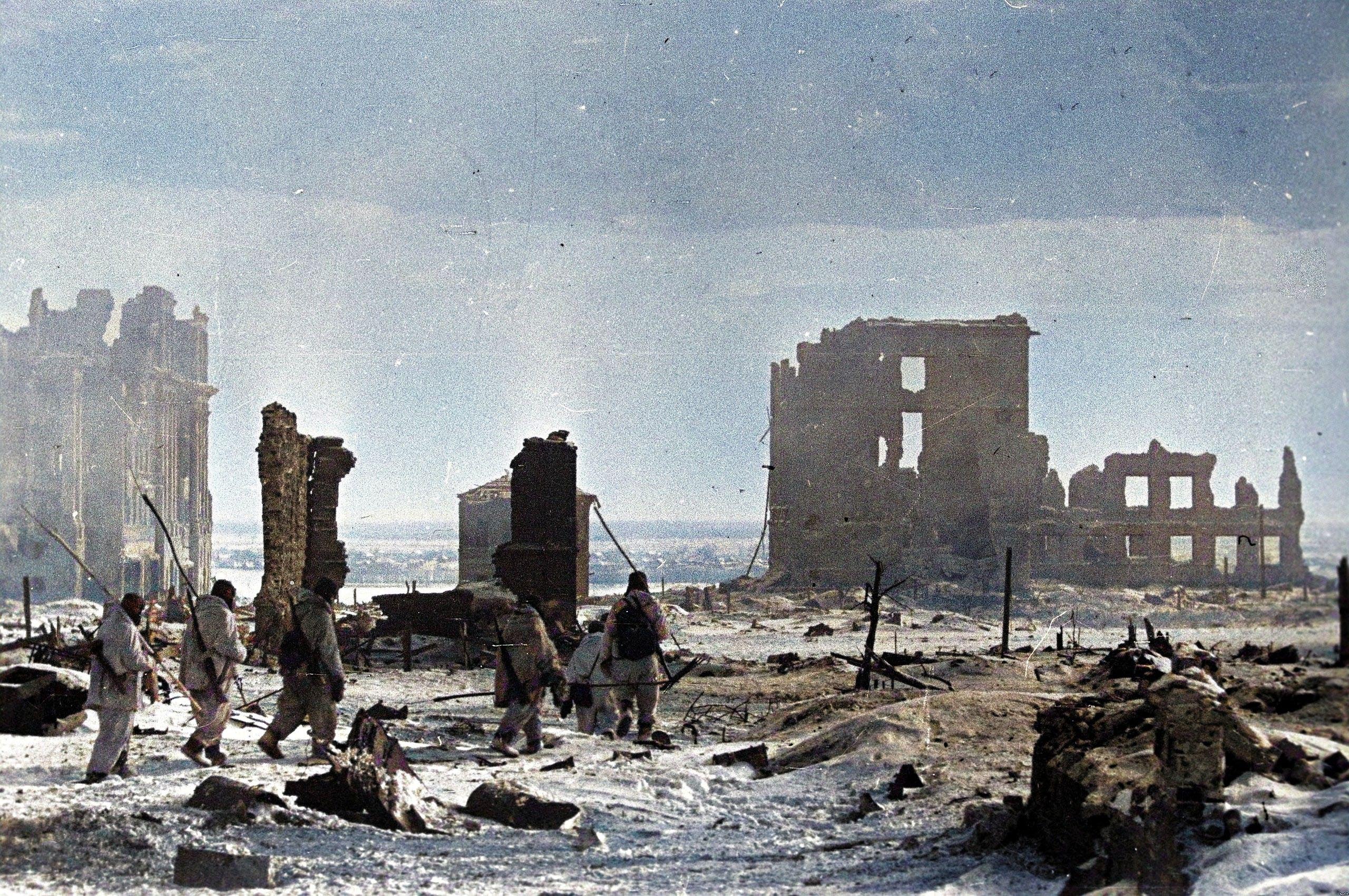
Catholic Christmas fell on December 25th. The German army celebrated it in complete defeat, in the basements of Stalingrad.
Instead of long tables covered with white tablecloths and filled with decorated plates of roasted goose, potato salad, apple strudel, and hot mulled wine, gray wooden tables with remnants of provisions stood before the best people of the Aryan race. Christmas candles found somewhere were stuck in the necks of bottles. The uprooted Christmas trees stood without decorations.
Soviet leaflets flew from the sky.
To the Commander of the Encircled 6th German Army near Stalingrad — General Field Marshal Paulus or his Deputy.
The 6th German Army, units of the 4th Tank Army, and the attached reinforcement units have been completely surrounded since November 23, 1942. Units of the Red Army have encircled this group of German troops with a tight ring.
<...>
Your situation is hopeless, and further resistance makes no sense. We guarantee all officers, non-commissioned officers, and soldiers who have ceased resistance their lives and safety, and after the end of the war — their return to Germany. We allow all surrendered personnel to keep their military uniforms, insignia, medals, personal belongings, valuables, and the senior officer corps to keep their cold weapons.
Your answer is expected at 3:00 PM Moscow time on January 9, 1943 in writing through your personally appointed representative who must travel in a passenger car with a white flag.
The Germans dropped similar leaflets during their advance. They were titled “Stalingrad has fallen!” — and it was a bluff. Now the Germans themselves received similar leaflets. Were they bluffs of Soviet propaganda?
“I want to tell you something else,” I took out a leaflet about the surrender from my pocket and handed it to the professor. His expression became more and more serious.
“Does Paulus have the courage for this?” said the doctor aloud. “The Supreme Command of the Red Army assesses our situation absolutely correctly. They have all the capabilities to destroy us. They can do it in two or three weeks.”
“So, you support capitulation, Mr. Lieutenant Colonel?”
“It’s not about my personal capitulation, it’s about whether Paulus will give the order to lay down arms. In my opinion, he must do this for the sake of the interests of the German people.”
“Why for the sake of the interests of the German people? After all, the commander obeys Hitler. Will he really disregard the Führer’s order?”
“And who is Hitler? Do you really believe that he represents national interests? Do you believe in his National Socialism? All his words are nothing more than empty talk. Hitler is the epitome of unlimited power.”
“Without power, you can’t do anything.”
“Right. Only power needs to be put in the service of the people’s good. Or do you think that if a quarter of a million German citizens perish here, on the banks of the Volga, it will make our people happier?..”
“Mr. Lieutenant Colonel, your words are literally killing me. I also have many doubts. And I have long been arguing with myself. But I cannot believe that Hitler is preparing the fate of the 6th army for the entire German people.”
“At one time, I thought the same way as you. I believed that the Führer could lead Germany out of the economic crisis. I believed that he represented the interests of Germany, which would achieve real prosperity and recognition throughout the world. I hoped that a Germany would be created in which justice, freedom of conscience, and religion would prevail for all. But I was bitterly mistaken. I think that General Field Marshal Paulus sees no worse than the gentlemen from the Führer’s headquarters in Vinnitsa that his army is doomed to destruction. And he must make a choice: either blindly follow the Führer’s orders, or save the lives of his subordinates soldiers. And no one can take away this decision from him.”
“How do you think he should act?”
“I think the most reasonable thing to do now is to agree to surrender. In military terms, this is not only an honest decision but even a direct duty. And if Paulus orders his troops to continue resistance, he will commit a crime that may be the worst in all of German military history.”
On January 9, 1943, General Field Marshal Friedrich Wilhelm Paulus of the Wehrmacht’s 6th army refused to surrender.
Paulus
General Paulus was a talented military leader. His army fought in Poland, Belgium, and the Netherlands, and he himself participated in the development of the plan called ’Barbarossa' — the blitzkrieg on the Eastern Front, which was a lightning-fast invasion of the Soviet Union.
Friedrich Paulus
Field Marshal of the Wehrmacht’s 6th army, which attacked Stalingrad.
In 1942, Paulus was promoted in rank and appointed commander of the “famous” 6th army — the same one that was surrounded at Stalingrad. In general, Paulus had many awards since the time of the German Empire: two Iron Crosses, an Order for Military Merit, a Knight’s Cross, a Long Service Medal in the Wehrmacht, and others.
And here the talented General Paulus, together with his staff, is languishing in the basement of the Stalingrad department store. Understanding the failure of the Caucasus campaign, Hitler offers Paulus a rather original solution — to shoot himself. He doesn’t say it directly; instead, on January 30, 1943, he awards Paulus the rank of Field Marshal and says that “no German Field Marshal has ever been taken prisoner”.
By this time, the outcome of the battle had long been predetermined, and Hitler’s treachery was obvious. Paulus ignores his “tempting” offer.
On January 30, 1943, exactly at one o’clock, the German and Romanian units around the ruins of the department store ceased fire. White flags and simply pieces of cloth hung on the rubble announced the surrender. The Russians also stopped shooting.
And then the winners appeared — strong, rosy-cheeked, in fur hats, valenki and fur coats. Guns on their chests or in their hands. “Life and death,” the comparison involuntarily flashed through my mind when I saw the healthy, strong Red Army soldiers and the ghostly figures of German soldiers emerging from basements.
The first to arrive in the basement of the department store were the soldiers of the 38th Motorized Rifle Brigade under the command of Sergeant Petr Altukhov. In addition to Paulus, dozens of German officers, hundreds of sick and wounded, and an incredible stench were found in the basement.
The newly appointed Field Marshal of Germany himself was found powerless, lying on an iron bed in just a shirt.
We immediately saw Paulus. Dressed in a coat, with his hands clasped behind his back, he slowly walked from one side of the room to the other. I entered the room. Paulus turned towards the door and, upon seeing me, stopped.
The fifty-three-year-old field marshal was above average height, thin, perhaps overly straight, tight and well-groomed. Now his face was pale. He looked at us with tired eyes. I introduced myself and declared him a prisoner.
Paulus approached me and, raising his right hand high, said in poor Russian: “Field Marshal of the German Army Paulus surrenders to the Red Army as a prisoner.”
On February 2, 1943, the 6th Army of the Wehrmacht, led by Field Marshal Friedrich Wilhelm Paulus, surrendered. 92 thousand people, including 2500 officers and 24 generals, surrendered. The Battle of Stalingrad was over.
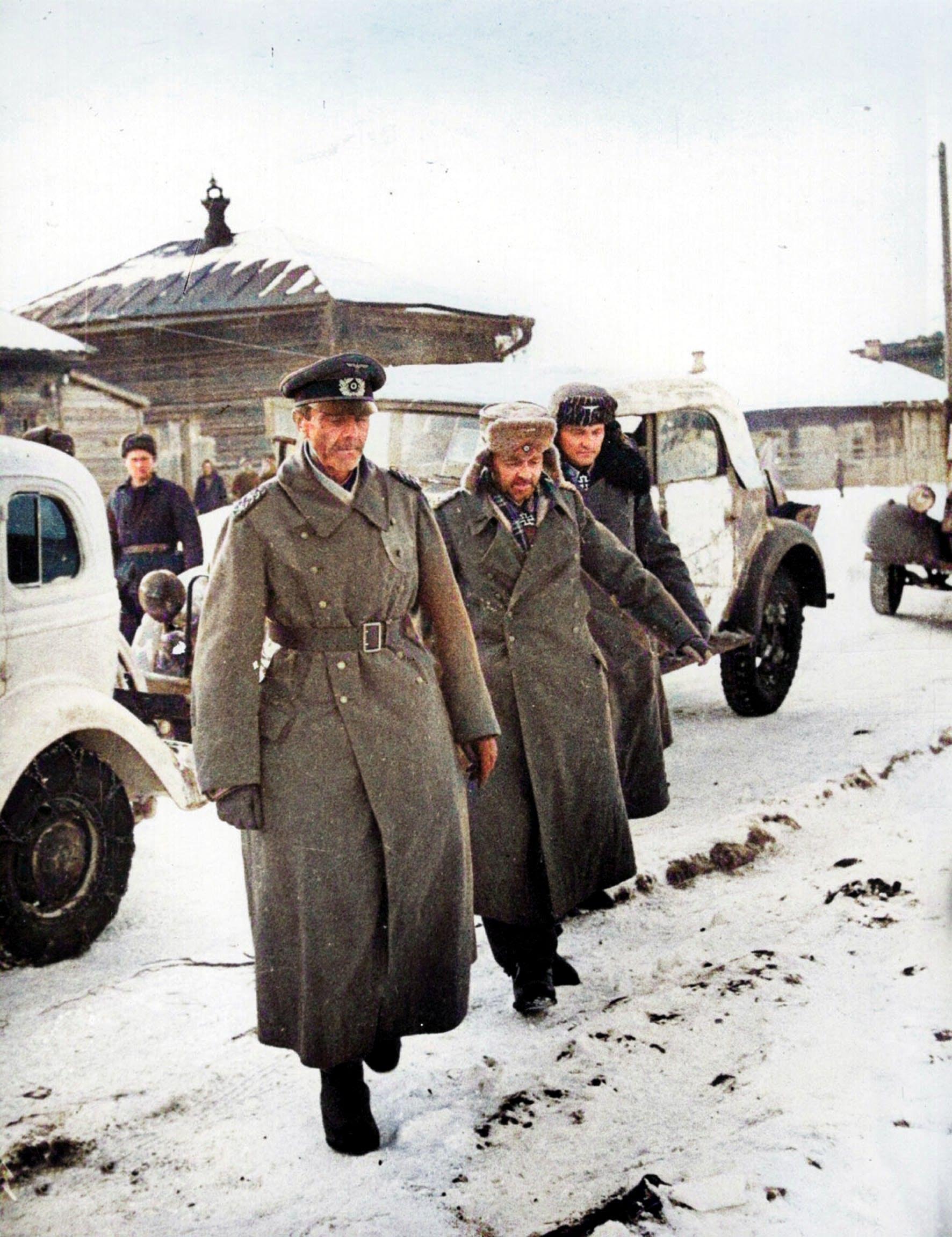
Aftermatch
During the Battle of Stalingrad, almost 3 million people were affected. Among them were 1.5 million fascist soldiers and 1.13 million Soviet soldiers — irretrievable and sanitary losses.
The defeat at Stalingrad was a shock to Germany, both politically and morally. Trust in Hitler was undermined. The Axis “Berlin-Rome-Tokyo” was shaken. Japan realized the futility of war against the USSR and abandoned plans for an offensive in the Far East. Turkey finally refused to enter the war from the side of the Caucasus.
The defeat at Stalingrad horrified both the German people and their army. Never before in the history of Germany had there been such a terrible loss of troops.
Meanwhile, Soviet soldiers and civilians began to return to the destroyed city of Stalingrad. In the city center, amidst the ruins, people celebrated the victory: they danced to accordion music, danced in circles, and joyfully hugged each other. Nazi flags were taken down from buildings and replaced with Soviet flags.
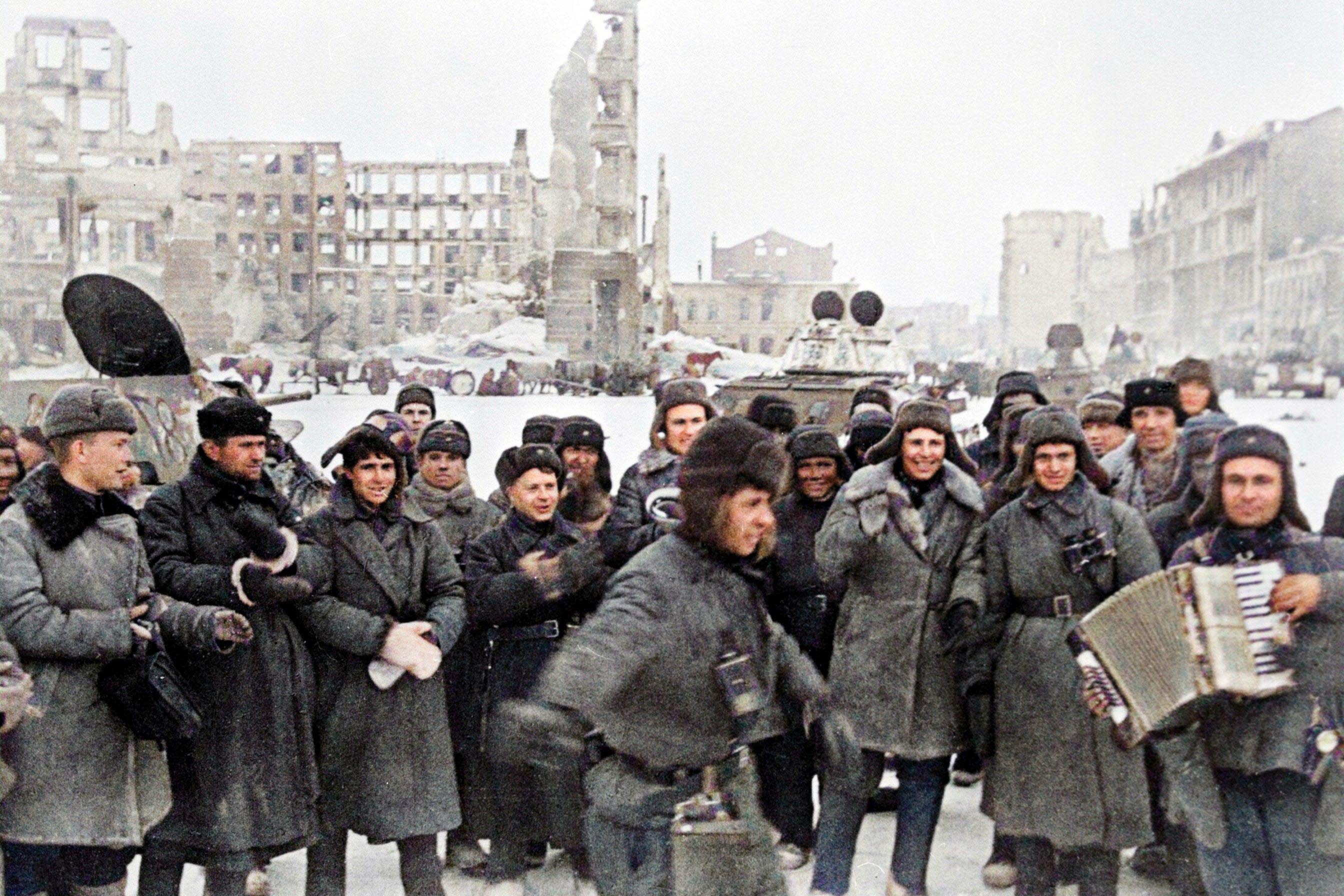
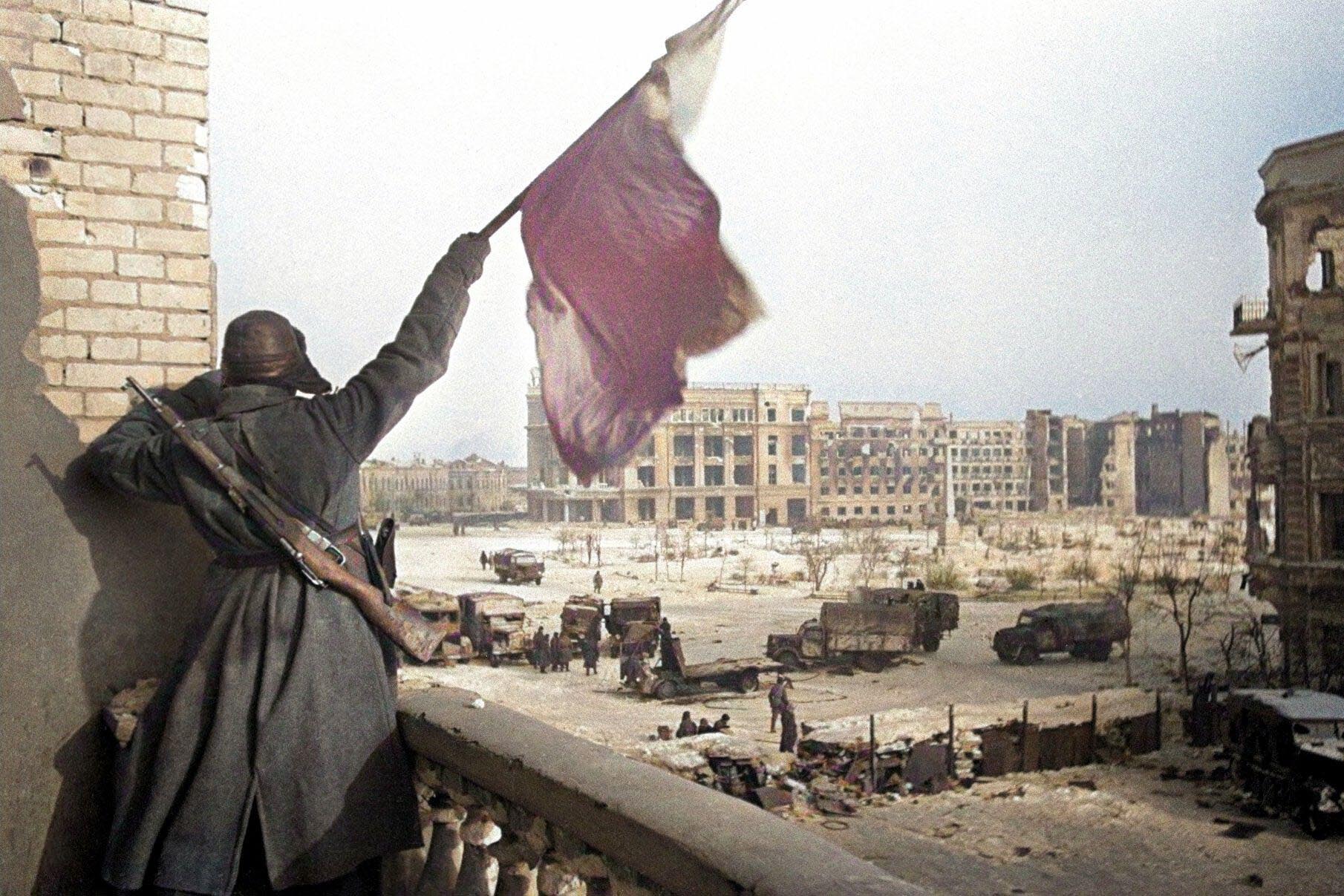
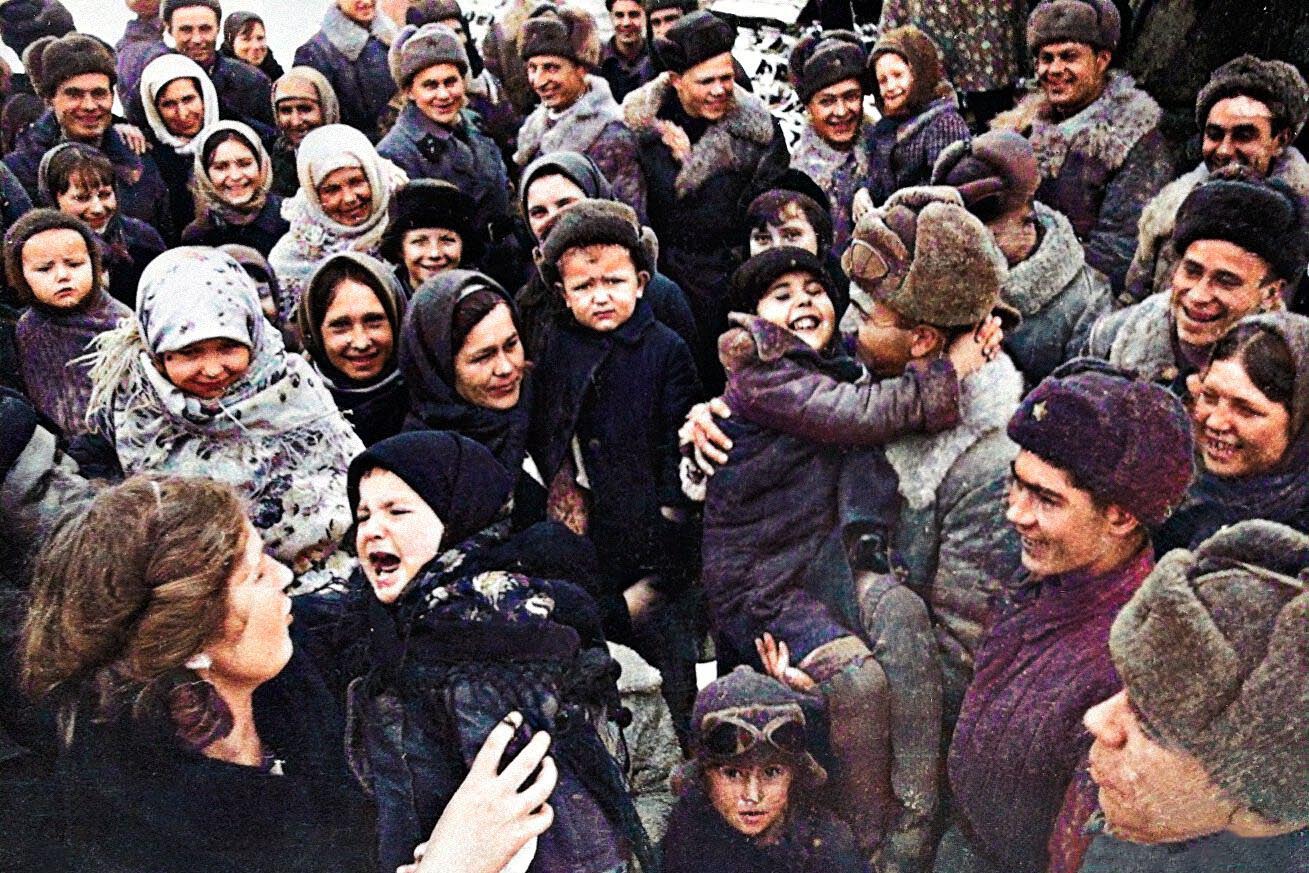
Meanwhile, panic and confusion began in the Third Reich. For the first time in the entire history of World War II, mourning was declared in Germany. Even before the end of the Battle of Stalingrad, in January 1943, prices on the German stock exchange were frozen, and a year later trading was completely suspended.
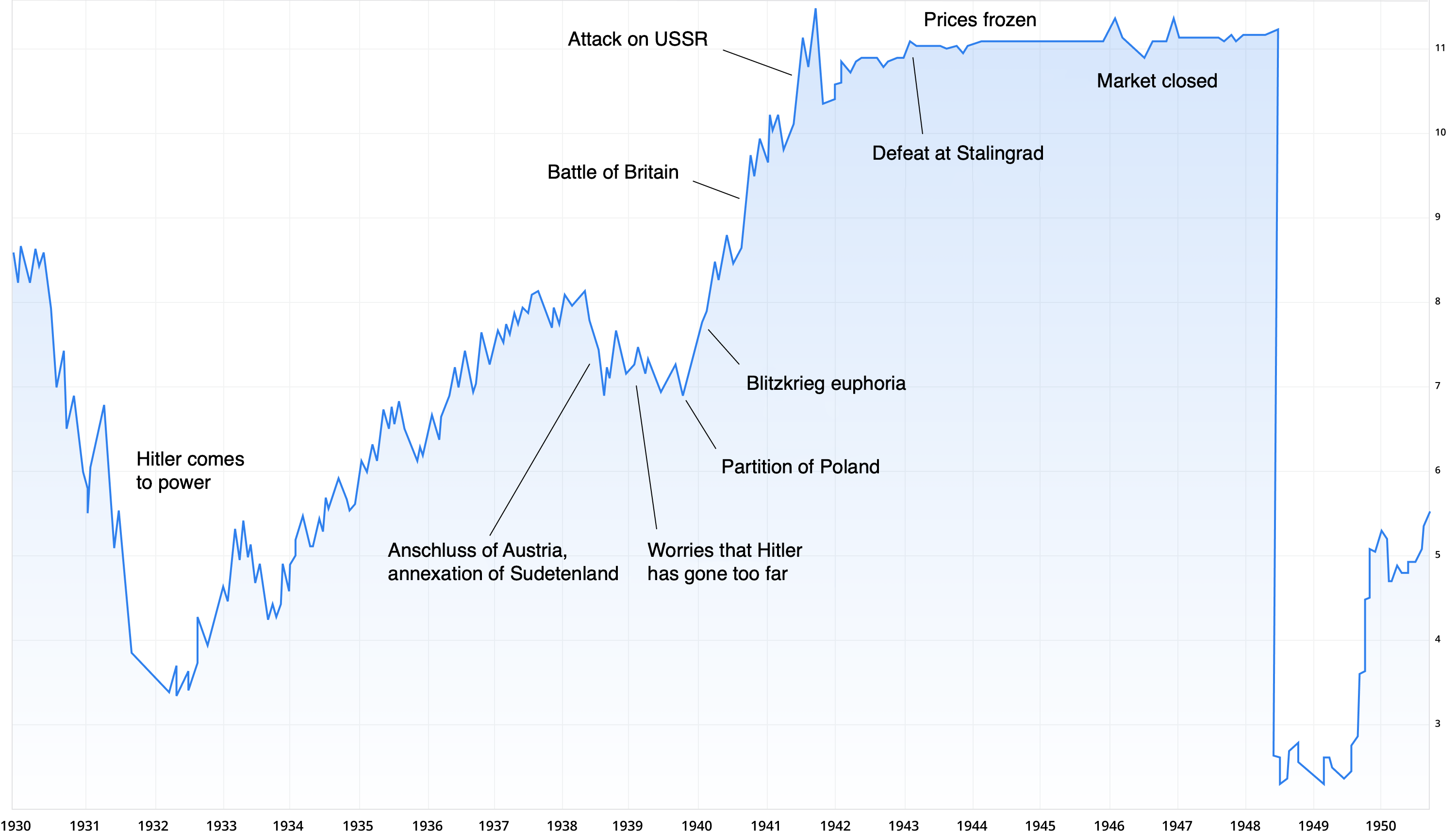
In January 1943, simultaneously with the victory at Stalingrad, Soviet forces defeated a significant part of the enemy’s troops near Leningrad, which made it possible to improve the supply of the city dying of hunger.
In February 1943, a group of saboteurs in Norway disabled a German heavy water production plant necessary for creating an atomic bomb. Hitler was still far from producing an atomic bomb; after a series of sabotage actions, even the faint possibility of its creation was lost.
In the spring, the Eastern Front formed a bulge known as the Kursk Arc. British intelligence officers Kim Philby and John Cairncross provided accurate information to the Soviet leadership about the German offensive. They were also able to obtain technical specifications for new German tanks, including the “Tiger”. Thanks to this data, the USSR not only completely defeated the Hitlerite army, but also with “Russian scope” destroyed almost 3,000 German tanks. During the battle, Kursk and Kharkov were liberated.
In May, the British finally defeated General Rommel’s army in North Africa, making the landing on the island of Sicily possible. Hitler, having just begun a counter-offensive on the Kursk Arc, was forced to withdraw some troops and send them to defend Italy. The Germans were finally defeated near Kursk, Mussolini was arrested in Italy and the fascist party was liquidated.
By the end of 1943, Kiev was liberated. A conference of leaders from three countries — Stalin, Churchill, and Roosevelt — took place in Tehran. Leningrad was finally liberated in January 1944. Crimea was liberated by the end of spring. In the summer, the Allies began landing in Normandy. Rome, Paris, and Minsk were liberated. In the fall, Brussels, Tallinn, Warsaw, Prague, Athens, and Belgrade were recaptured.
At the end of April 1945, Mussolini was executed. Hitler committed suicide. In early May, the Red Army stormed Berlin and Germany surrendered.
The Second World War was coming to an end.


